NavSource Online: Aircraft
Carrier Photo Archive
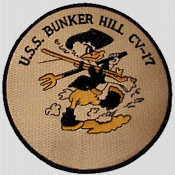
Patch contributed by Mike
Smolinski
USS BUNKER HILL (CV-17)
(later CVA-17, CVS-17
and AVT-9)




Flag
Hoist/Radio Call Sign: November - Bravo - Alpha - Papa
Tactical Voice Radio Call: "EXPOSE"
http://www.navsource.org/archives/02/17.htm |
Unit Awards,
Campaign and Service Medals and Ribbons






Precedence of awards is from top to bottom, left to right
Top Row: Presidential Unit Citation / American Campaign
Medal / Asiatic-Pacific Campaign Medal (11 stars)
2nd Row: World War II Victory Medal / Philippine
Presidential Unit Citation / Philippine Liberation Medal
(Click
here for further detail)
| Essex
Class Aircraft Carrier |
| Ordered
| Laid down
| Launched
| Commissioned
| Decommissioned
| Stricken
|
| 9 Sep 1940 |
15 Sep 1941 |
7 Dec 1942 |
24 May 1943 |
9 Jan 1947 |
1 Nov 1966 |
| Builder: Bethlehem Steel Corp.,
Fore River, Quincy, Mass. |
- Named
after the battle fought, June 17, 1775 on Breed's Hill,
adjacent to Bunker Hill (a height in Charlestown, Mass.)
- On the morning of 11 May 1945, while supporting the
Okinawa invasion, USS Bunker Hill was hit
and severely damaged by two kamikazes. She suffered
the loss of 346 men killed, 43 missing, and 264 wounded.
Although badly crippled she managed to return to Bremerton
via Pearl Harbor.
- Repaired and returned to active service, but did not
resume flight operations, as she served as part of the
"Magic Carpet" fleet, returning veterans from
the Pacific until decommissioned.
- Laid up in excellent condition and retained awaiting the
"ultimate" Essex-class modernization,
which never materialized.
- Reclassified as an "Attack Aircraft Carrier"
and redesignated CVA-17, 1 October 1952, while in reserve.
- Reclassified as an "Antisubmarine Warfare Support
Aircraft Carrier" and redesignated CVS-17, 8 August
1953, while in reserve.
- Reclassified as an "Auxiliary Aircraft
Transport" and redesignated AVT-9, May 1959, while in
reserve.
- Fate: Although struck from the Naval
Vessel Register, her hulk was used as a stationary
electronics test platform at San Diego until November
1972. Sold for scrapping in May 1973. About 600 tons of
her armor plate have been put to use at the Fermi
National Accelerator Laboratory.
Specifications
(As built, 1943)
Displacement: 27,100 tons standard; 36,380 tons
full load
Dimensions (wl): 820' x 93' x 28.5' (full load) / 249.9
x 28.3 x 8.7 (full load) meters
Dimensions (max.): 872' x 147.5' / 265.8
x 45 meters
Armor: 4"-2.5" belt; 1.5" hangar
& protective deck(s); 4" bulkheads; 1.5" STS
(top, side of pilot house); 2.5" (top) steering gear
Power plant: 8 boilers (565 psi, 850°F); 4
steam turbines; 4 shafts; 150,000 shp (design)
Speed: 32.7 knots
Endurance (design): 20,000 nautical miles @ 15
knots
Armament: 4 twin & 4 single 5"/38 gun
mounts; 8 quad 40-mm/56-cal gun mounts; 46 single 20-mm/70-cal
guns mounts
Aircraft: 92 (Air Group 17, June 1943)
Aviation facilities: 1 deck-edge, 2 centerline
elevators; 1 flight deck, 1 hangar deck catapults
Crew: 2,600+ (ship's company + air wing, as
designed)
Click On Image
For Full Size Image |
Size |
Image Description |
Contributed
By And/Or Copyright |
Name:
The Battle of Bunker Hill
|

NS021737 |
117K |
CV-17 was named for the Battle of Bunker Hill, June
17, 1775 which, in fact, was mostly fought on adjacent
Breed's Hill. The battle was part of the siege of
Boston during the Revolutionary War. General Israel
Putnam was in charge of the revolutionary forces,
while Major-General William Howe commanded the British
forces. Although Howe's immediate objective was
achieved, it did not affect the siege and the British
suffered more than 1,000 casualties — British
General Henry Clinton wrote in his diary that "A
few more such victories would have surely put an end
to British dominion in America."
The famous order, "Don't fire until you see
the whites of their eyes" was allegedly given by
an American officer and popularized by stories about
Bunker Hill, but it is not certain who, if anyone at
this battle, gave it.
NS021737.
"The Battle at Bunker's [sic]
Hill," drawing by Henry A. Thomas; published
by C. Frank King, Boston, c.1875. Library of Congress
reproduction # LC-USZ62-4430.
NS021737a.
An illustrated map of the battle ground on Charlestown
peninsula, encompassing Bunker and Breed's Hills, from
"History of the Battle of Bunker's [Breed's
Hill] on June 17, 1775," George E. Ellis;
Boston, 1875.
|
Library of Congress |

NS021737a |
282K |
US Army |
World
War II
|

NS021741 |
535k |
USS Bunker Hill (CV-17), World War
II.
Overhead plan and starboard profile meticulously
drawn by John Robert Barrett. Available from Navy
Yard Associates (if you decide to purchase artwork
from them please indicate that you heard about their
work from NavSource).
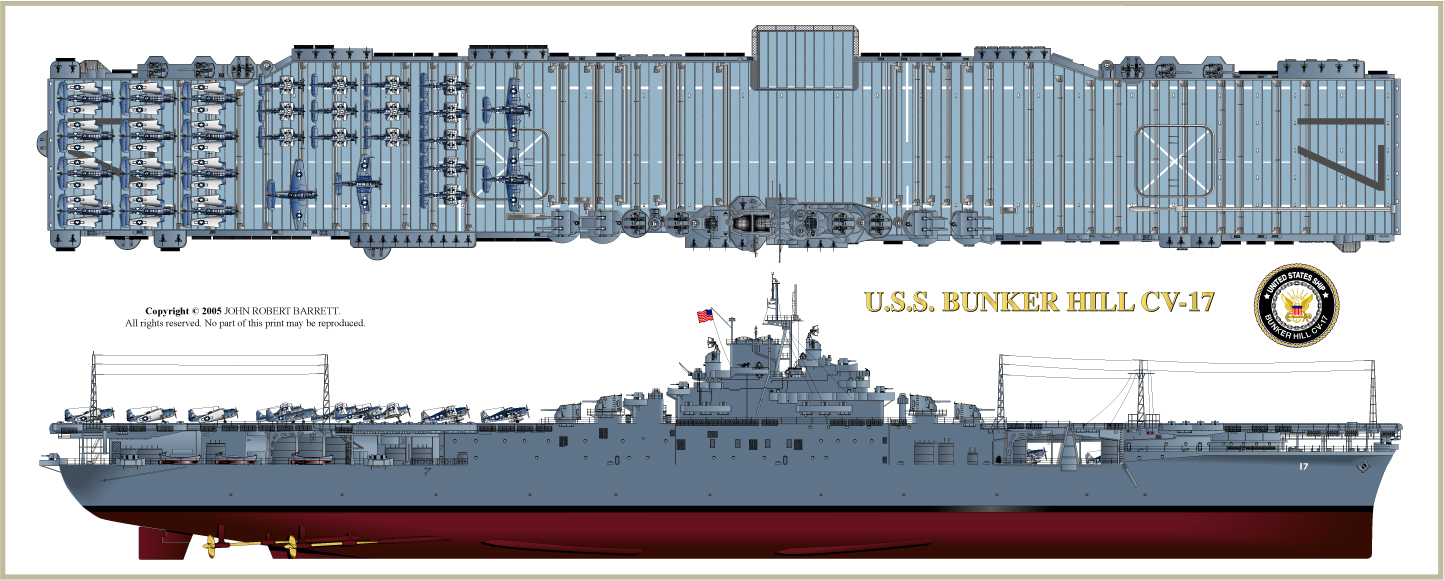
|
Navy
Yard Associates |

NS021713 |
90K |
Bunker Hill (CV-17) afloat
immediately after launching, at the Bethlehem Steel
Company's Fore River yards, Quincy, Massachusetts, 7
December 1942. Several tugs are in attendance and a
Navy blimp is overhead.
Official U.S. Navy Photograph, from the collections
of the Naval Historical Center (# NH 97290).
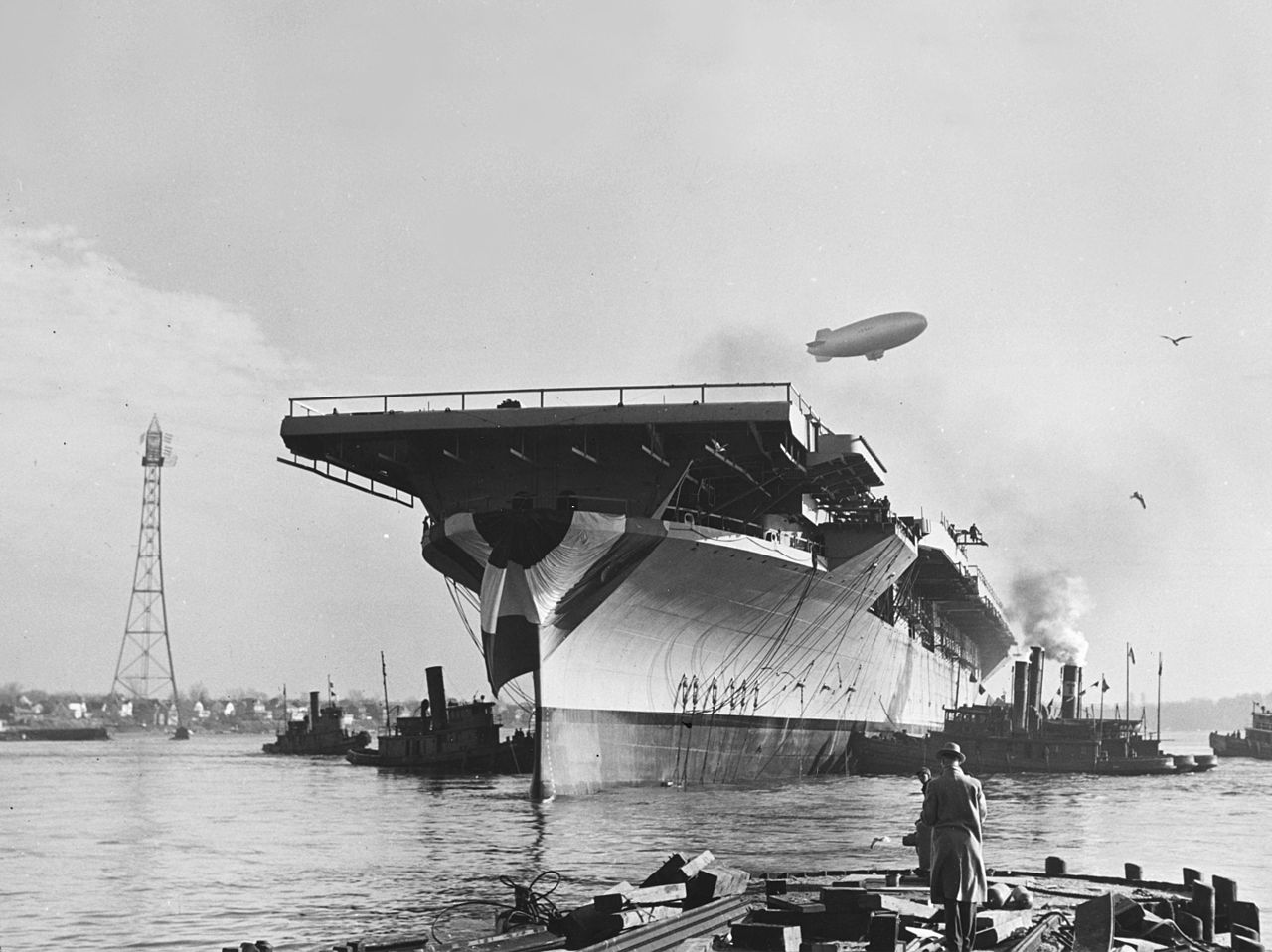
|
NHC |

NS021722 |
38k |
"This beautiful painting of the new aircraft
carrier, Bunker Hill was done by artist
Howard Grady, OS2c, USNR. It was presented to the
Captain, J. J. Ballentine, at the commissioning
ceremonies. Grady is well known for his portraits of
prominent people."
From Our Navy magazine, mid-September 1943
issue.
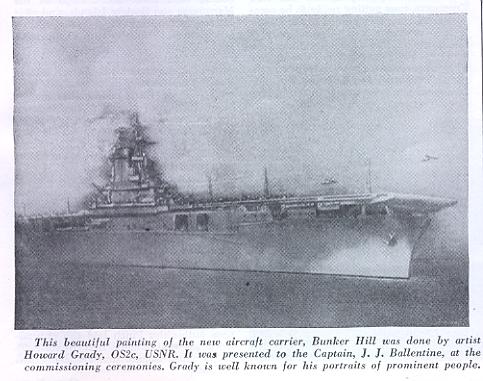
|
Chester O. Morris |
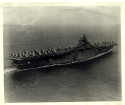
NS021747 |
72k |
This is believed to be a photo of USS Bunker
Hill (CV-17) during her shakedown cruise in
the summer of 1943. The key element is that the Air
Group has a mix of Helldivers and Corsairs,
still wearing pre-WW II-style markings, which appear
to be "17" in the original photo.
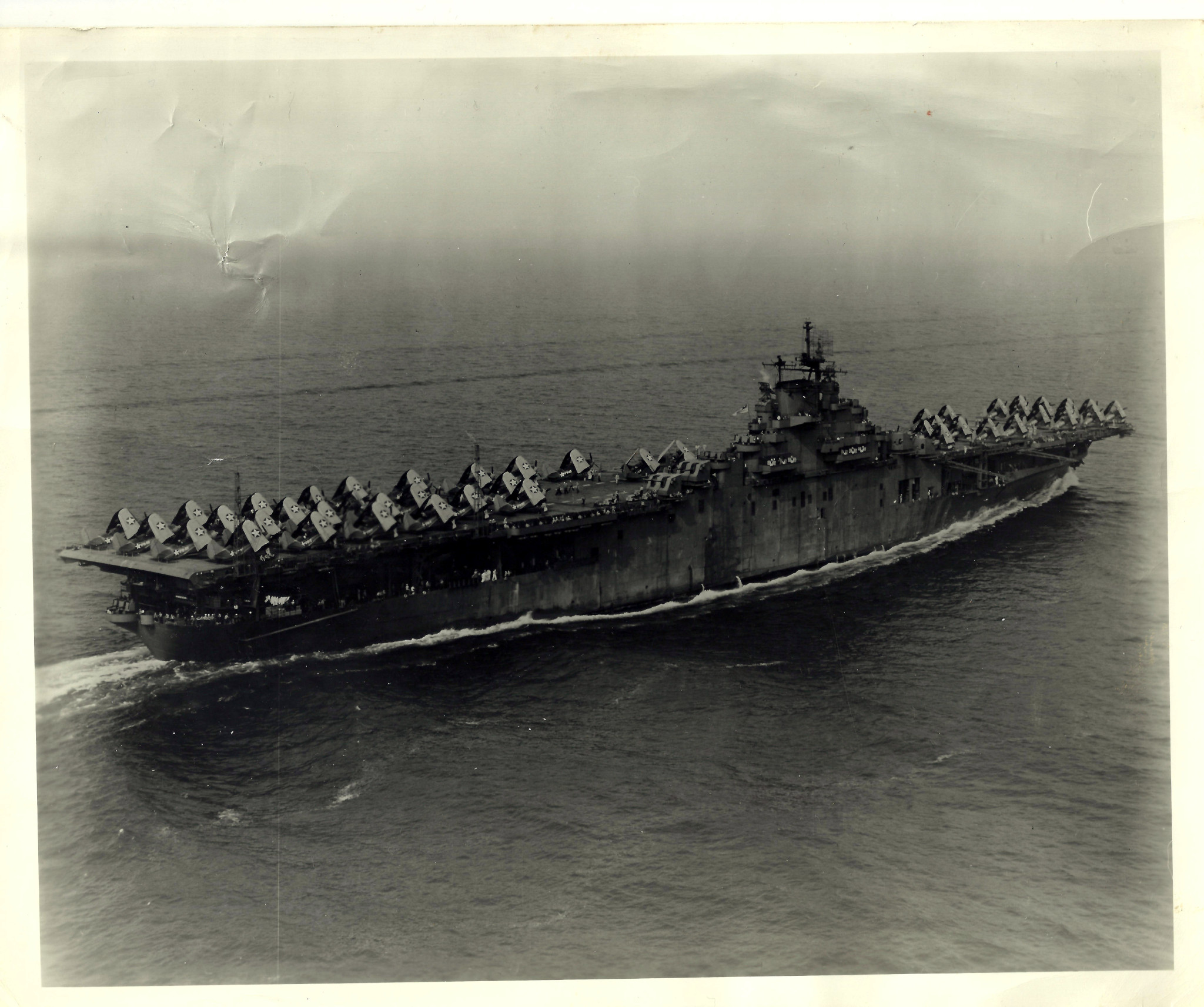
|
Robert M. Cieri |

NS021748 |
39k |
A landing mishap of a Curtiss SB2C-1 Helldiver
of Bombing Squadron (VB) 17 from Carrier Air Group (CVG)
17 aboard the aircraft carrier USS Bunker Hill
(CV-17) in 1943. The SB2C suffered from a lot of
design failures and required some 800 changes before
becoming fully operational. The crews therefore gave
the aircraft names like "The Beast" or
"Son of a Bitch, 2nd class" (SB2C). Note
that Bunker Hill seems to be equipped
only with the SC radar and not yet with the SK-1.
Photo from U.S. Navy Naval Aviation News,
February 1969.

|
Robert Hurst |

NS021748a |
101k |
A U.S. Navy Curtiss SB2C-1 Helldiver of
Bombing Squadron (VB) 17 pictured after losing its
tail during recovery aboard USS Bunker Hill
(CV-17) during operations in the Caribbean in 1943.
The first squadron to recive the Helldiver,
VB-17 experienced some growing pains with the type,
losing numerous aircraft while operating from shore
and aboard Bunker Hill during the
carrier's shakedown cruise.
National
Naval Aviation Museum, photo # 1996.253.292.
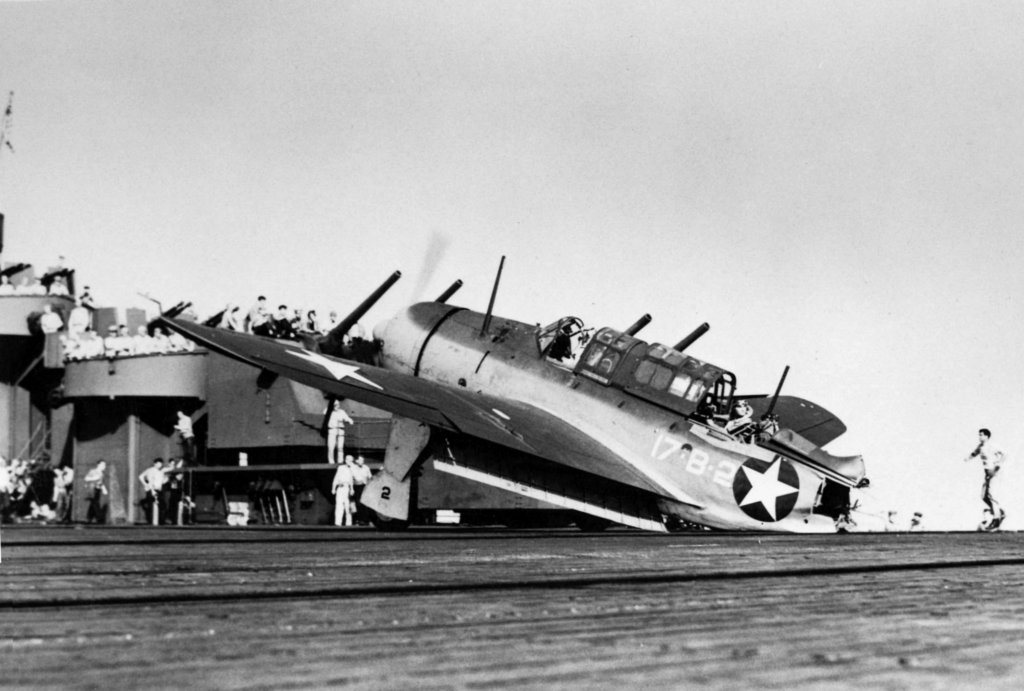
|
Courtesy of Scott Koen & ussnewyork.com |

NS021703 |
130k |
Newly arrived in the Pacific,
shown here underway with her deck full of aircraft.
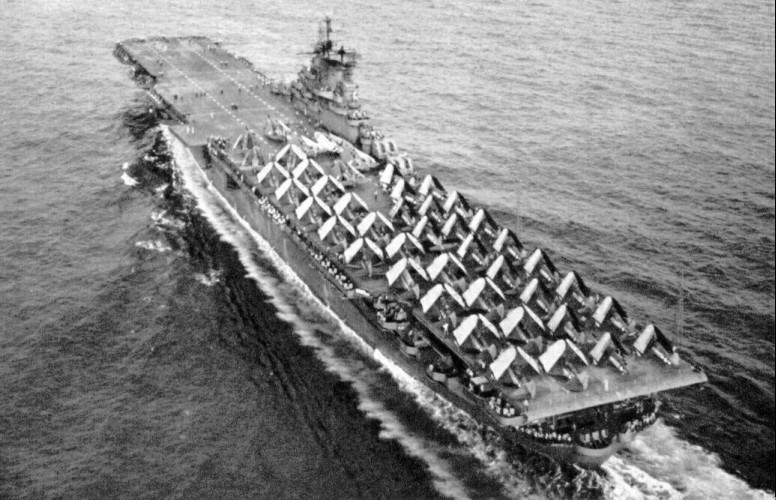
|
USN |

NS021706 |
177k |
Bunker Hill as seen
before she was struck by two bomb laden kamikazes.
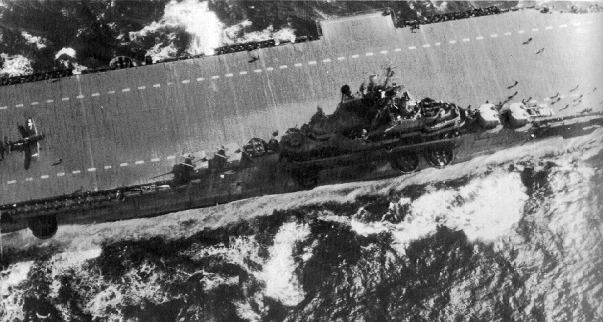
|
USN |

NS021726 |
131k |
Interesting view of VB-17 SB2C-1's turning into the
pattern to land aboard Bunker Hill after
their raid on Rabaul, November 11th, 1943. Photo by
Capt. Robert Wood.
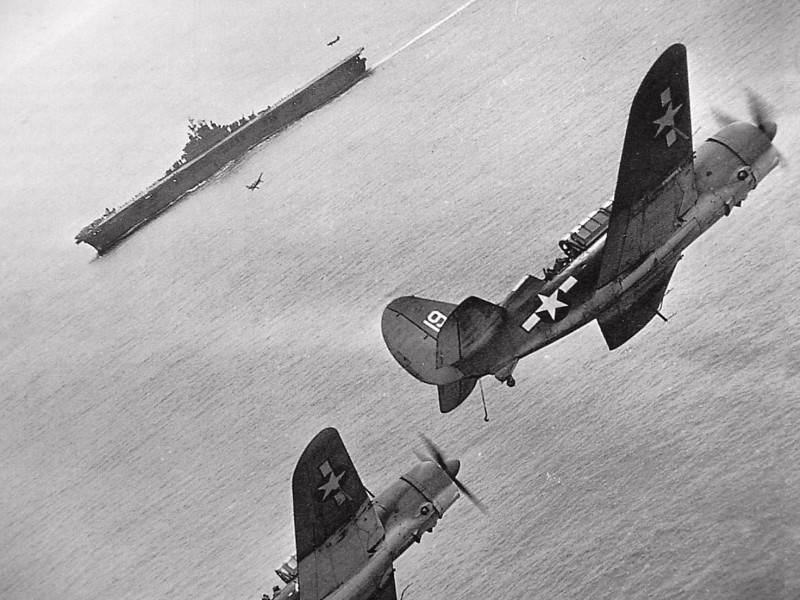
|
Steve Whitby |

NS021718 |
81k |
USS Bunker Hill (CV-17) at sea while
participating in strikes on the Palau Islands, 27
March 1944. She is painted in camouflage Measure 33,
Design 6A.
Official U.S. Navy Photograph, now in the
collections of the National Archives (photo #
80-G-K-1560).
Note: Though this was originally a color
image, the original "Aero Kodacolor"
transparency has lost all colors but red and can now
only be reproduced in monochrome.
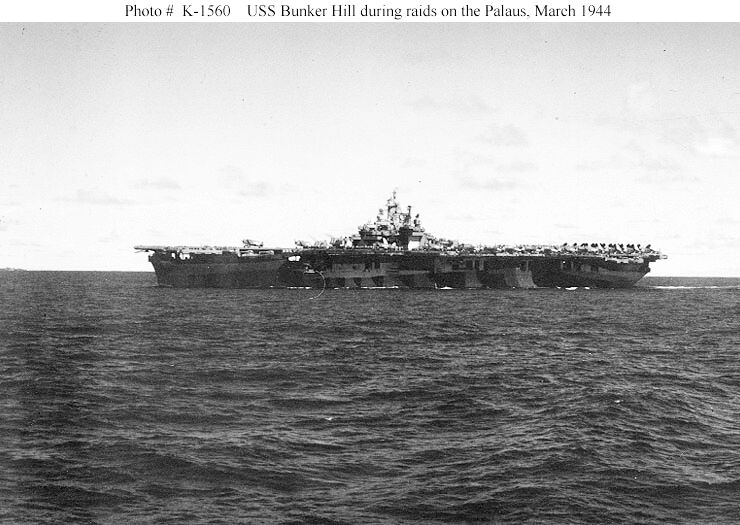
|
Scott Dyben |

NS021723 |
28k |
Believed to have been taken at Majuro atoll, May
1944.
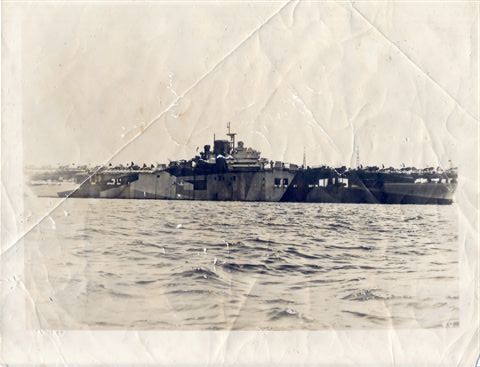
|
Mary Luz-Johnsen, daughter of Arthur Luz |

NS021716 |
67k |
Battle of the Philippine Sea, June 1944 —
USS Bunker Hill (CV-17) is near-missed
by a Japanese bomb, during the air attacks of 19 June
1944. The Japanese plane, with its tail shot off, is
about to crash, at left. Photographed from USS Monterey
(CVL-26).
Official U.S. Navy Photograph, now in the
collections of the National Archives (photo #
80-G-366983).
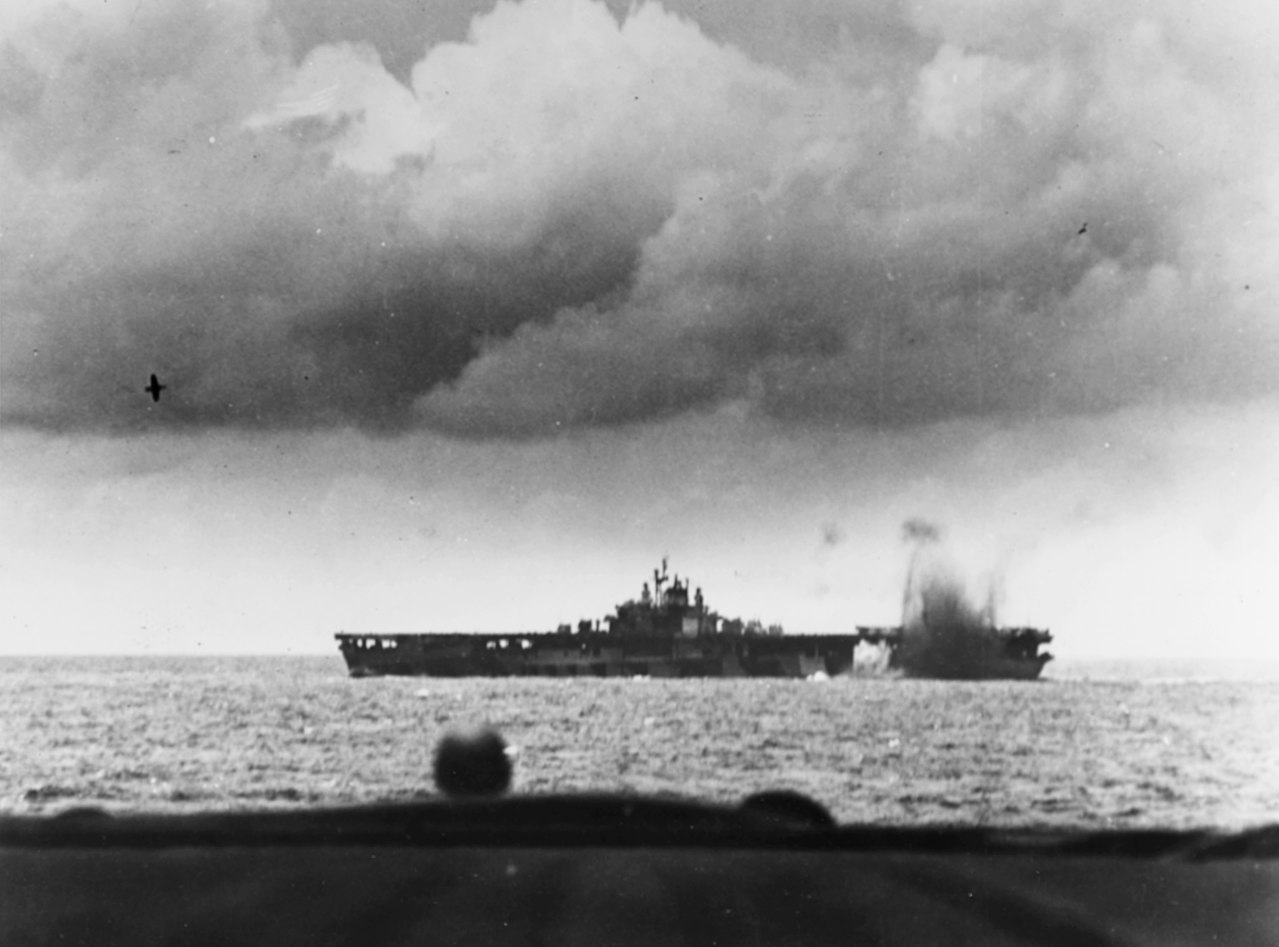
|
Scott Dyben |

NS021745 |
170k |
Rear Admiral Alfred E. Montgomery pictured with
Captain Thomas P. Jeter after presenting him the
Legion of Merit for service as skipper of the carrier Bunker
Hill (CV-17), 1944. Image is part of a
scrapbook assembled by Commander Francis N. Gilreath
during his service as Flag Secretary and Aide to Rear
Admiral Alfred E. Montgomery.
Photo courtesy of the National Naval Aviation
Museum.
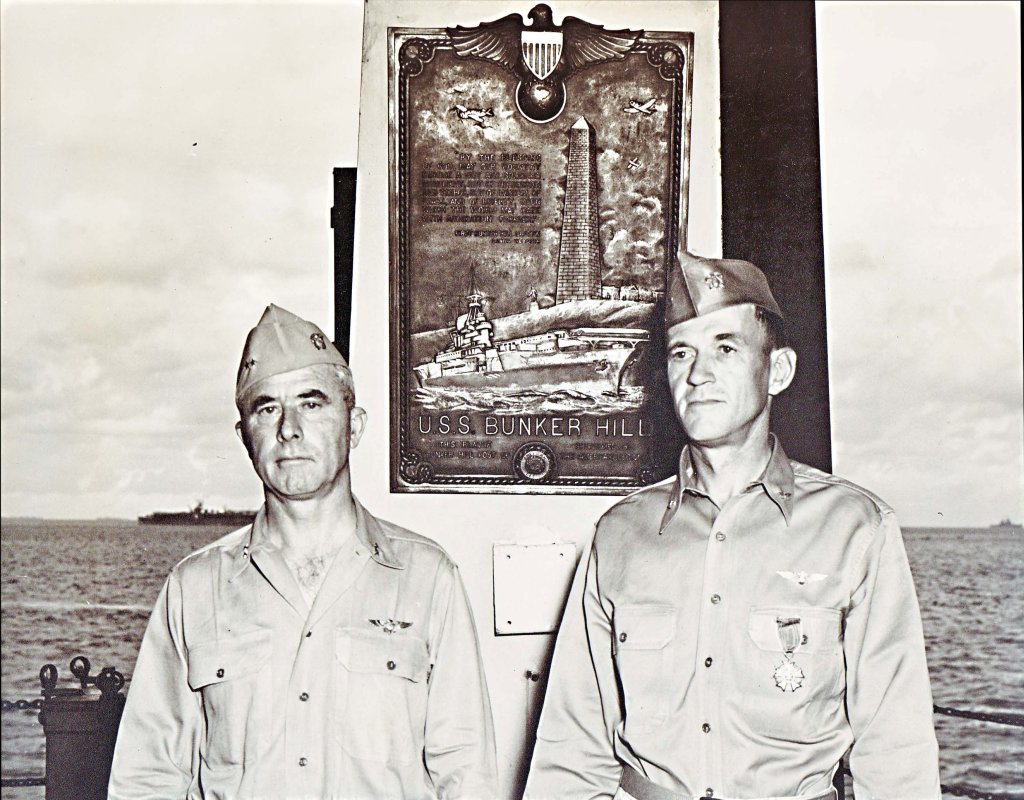
|
Bill Gonyo |

NS021742 |
86k |
A destroyer-escort (DE) dropping depth charges
while searching for Japanese submarines in Ulithi
anchorage on 20 November 1944, following the sinking
of USS Mississinewa
(AO-59). A Fletcher-class destroyer is steaming
past in the foreground. Two light cruisers (CL) and
several other ships are in the distance. Photographed
from USS Bunker Hill (CV-17).
Official U.S. Navy Photograph, now in the
collections of the National Archives (photo #
80-G-270650).
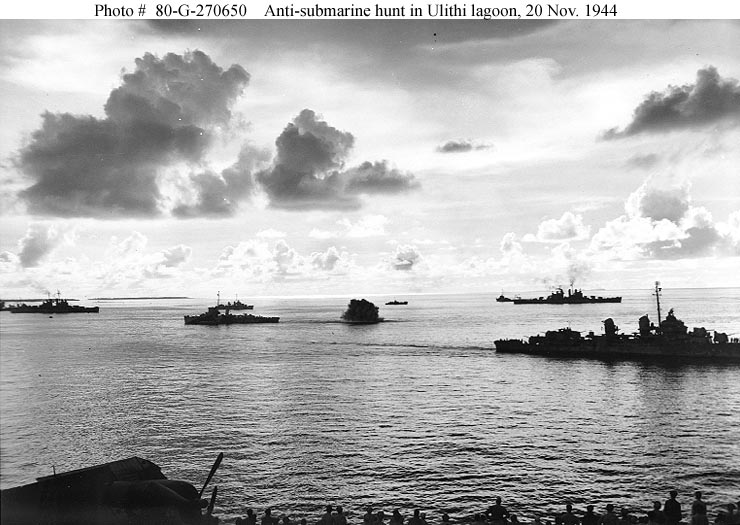
|
Naval History & Heritage
Command |

NS021742a |
105k |
Destroyer-escorts (DE) drop depth charges during
the search for Japanese submarines in Ulithi
anchorage, following the sinking of USS Mississinewa
(AO-59), 20 November 1944. A Fletcher-class
destroyer is in the left-center background, and an
anti-submarine net is in the distance. Photographed
from USS Bunker Hill (CV-17).
Official U.S. Navy Photograph, now in the
collections of the National Archives (photo #
80-G-270656).
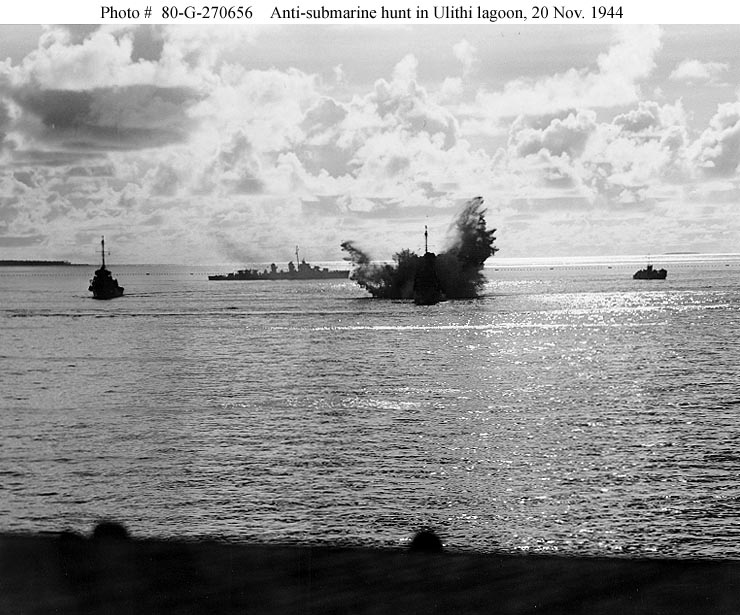
|

NS021742b |
89k |
A destroyer-escort (DE) drops depth charges while
searching for Japanese submarines in Ulithi anchorage
on 20 November 1944, following the sinking of USS Mississinewa
(AO-59). A Cleveland-class light cruiser (CL)
and other ships are in the distance. Photographed from
USS Bunker Hill (CV-17).
Official U.S. Navy Photograph, now in the
collections of the National Archives (photo #
80-G-270659).
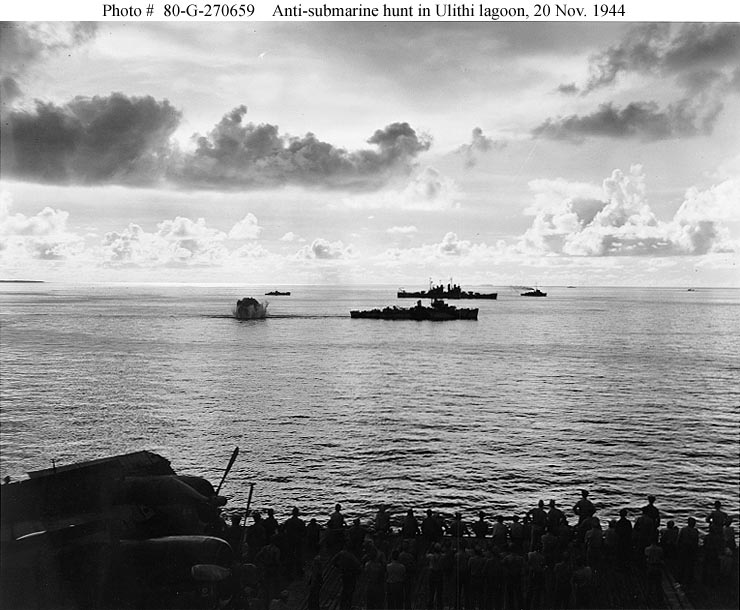
|

NS021749 |
67K |
USS Bunker Hill (CV-17) underway on
19 January 1945 after her period in dock at the Puget
Sound Navy Yard, four months before she was severely
damaged. The ship has a new camouflage scheme (Measure
21); there are two additional 40-mm quad mounts on the
port side at flight deck level, and also the usual
three below the island on the starboard side. The two
aft gun sponsons on the starboard side were extended
outwards and an extra AA mount was fitted right at the
stern. One of the three deck-edge masts was removed,
and the hangar catapult was removed and replaced by a
second flight deck catapult. US Navy photo.
Photo and text from Aircraft
Carriers of the U.S. Navy, by Stefan
Terzibaschitsch.

|
Robert Hurst |

NS021744 |
74K |
Vice Admiral Marc A. Mitscher, USN (right),
Commander, Task Force 58, confers with his Chief of
Staff, Commodore Arleigh A. Burke (at left), on board
TF58's flagship, USS Bunker Hill
(CV-17), during operations off Japan in February 1945.
Official U.S. Navy Photograph, now in the
collections of the National Archives (# 80-G-303981).
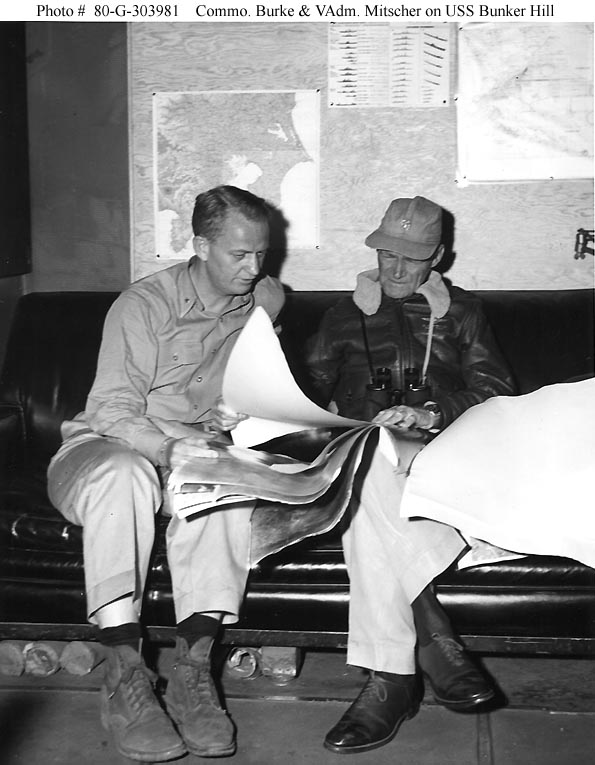
|
Naval History & Heritage Command |

NS021743 |
203K |
Task Group 58.3, under Rear Admiral Frederick C.
Sherman, departs Ulithi on 10 February 1945. Seen from
USS Bunker Hill (CV-17) are USS Cowpens
(CVL-25), left, and USS Essex
(CV-9), center.
Task Force 58 conducted attacks against the Tokyo
area (16–17, and 25 February) both to neutralize the
enemy's airpower before the landings on Iwo Jima (19
February) and to cripple the aircraft manufacturing
industry.
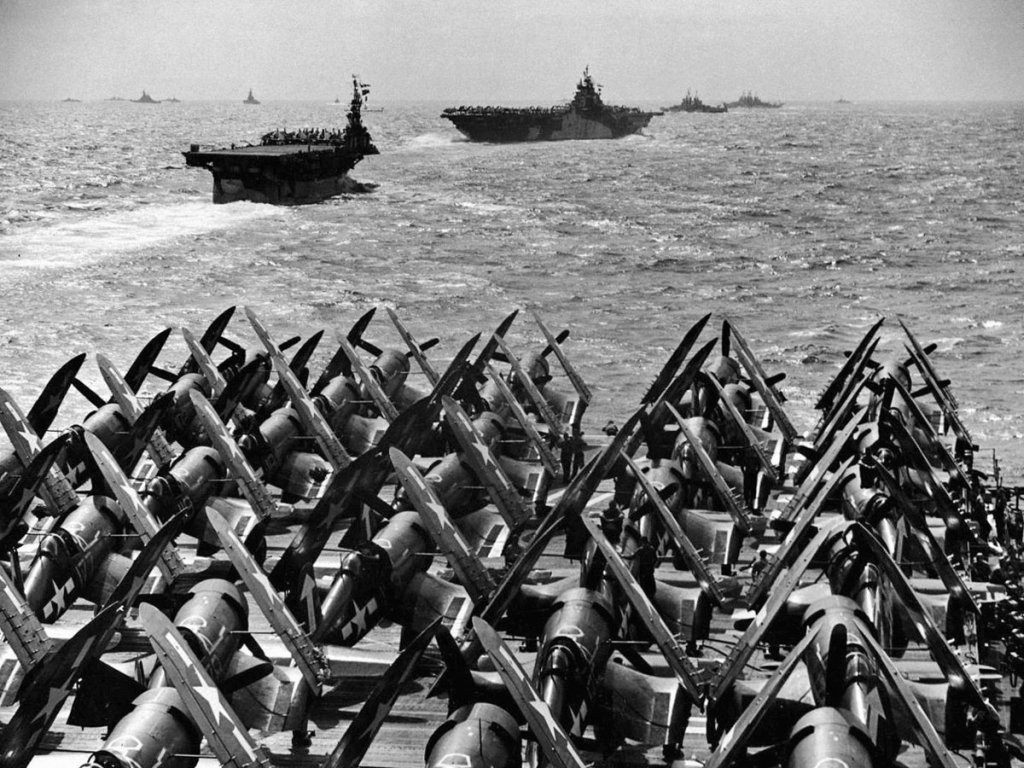
|
Pieter Bakels |

NS021739 |
144K |
USS Bunker Hill (CV-17) in a photo
probably taken circa the spring of 1945.
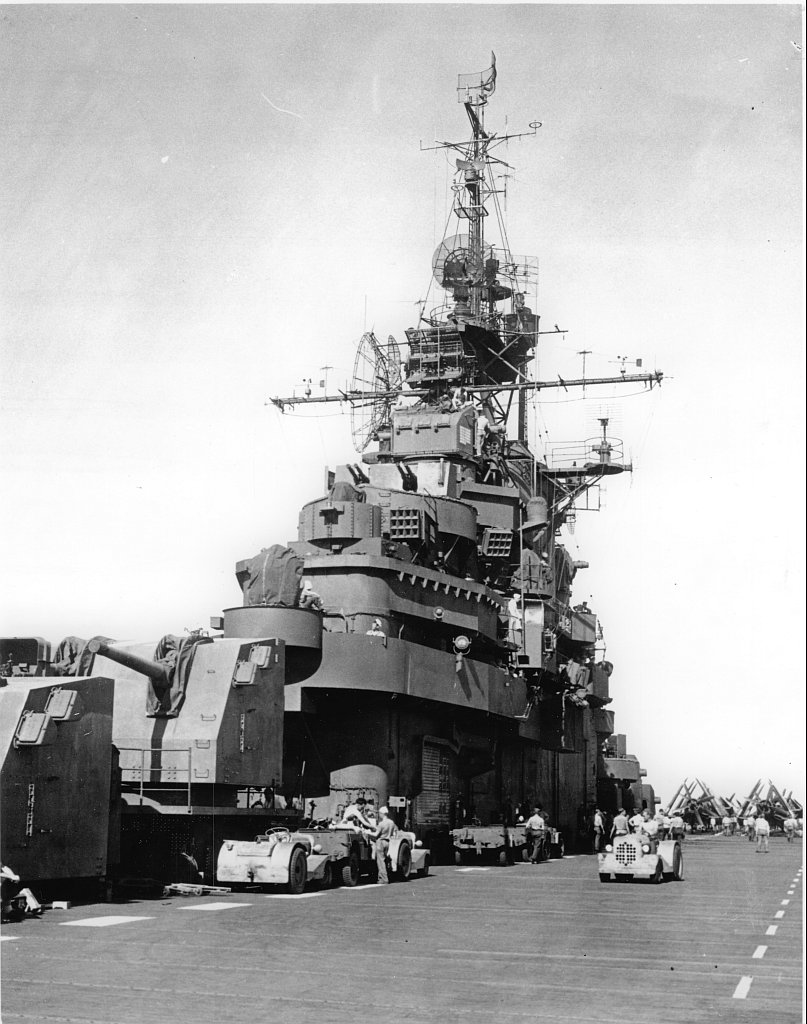
|
Pieter Bakels |

NS021733 |
118K |
USS Bunker Hill (CV-17) at sea in
1945 (although dated October 16, 1945 this picture is
older, as the ship did not operate aircraft after May
1945). This photo has been autographed by Admiral
Arleigh A. Burke, who served on board Bunker
Hill in January-May 1945, while he was Chief
of Staff to Admiral Marc A. Mitscher, Commander, Task
Force 58.
Collection of Admiral Arleigh A. Burke, USN. U.S.
Naval Historical Center Photograph (# NH 42373).
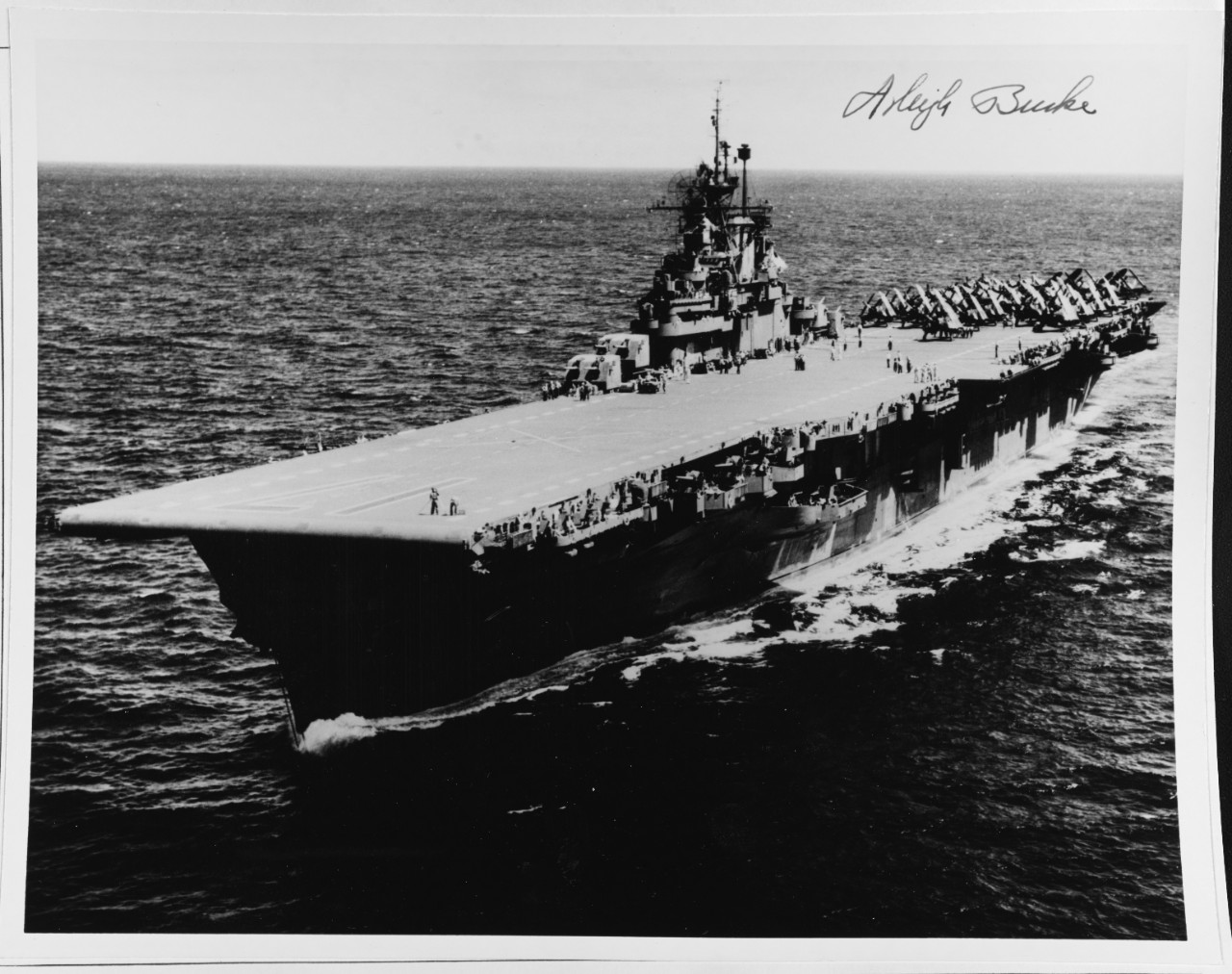
|
NHC |

NS021714 |
50K |
USS Bunker Hill (CV-17) underway in
Puget Sound, Jan. 19, 1945. The ship was commissioned
May 25, 1943, Capt. J. J. Ballentine in command.
Launched 7 Dec. 1942 by Bethlehem Steel Co., Quincy,
Mass. Redesignated CVS-17 Aug. 8, 1953.
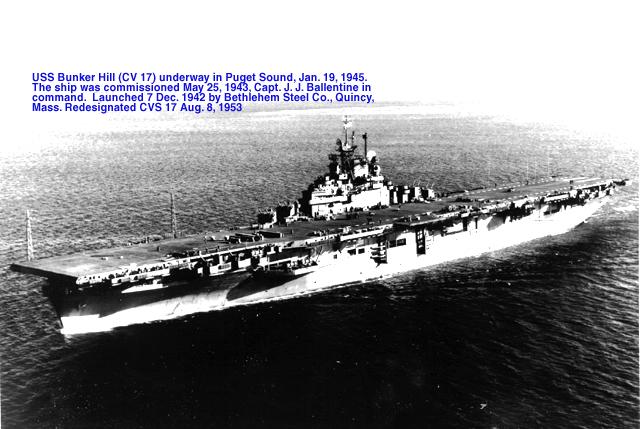
|
USN |

NS021717 |
91k |
At sea during strikes against targets on Kyushu,
Japan, 18 March 1945. USS New Jersey (BB-62) is
in the right distance. Photographed from USS Essex
(CV-9).
Official U.S. Navy Photograph, now in the
collections of the National Archives (photo #
80-G-373737).
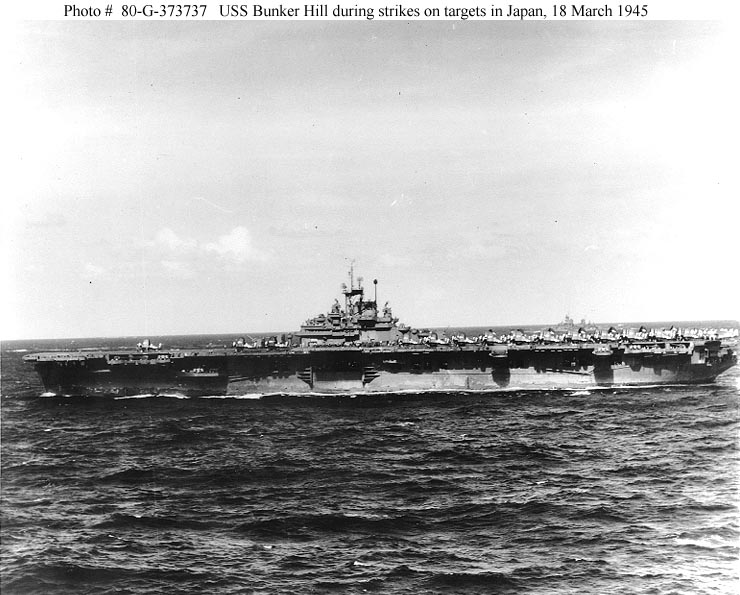
|
Scott Dyben |
Kamikaze
Attack, May 11, 1945
|
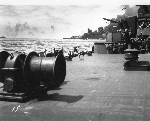
NS015701a |
304k |
USS Bunker Hill (CV-17) burning as
gas and ammunition explode after being attacked by
Japanese suicide divers, as seen from USS South
Dakota (BB-57), 11 May 1945.

|
Pieter Bakels |
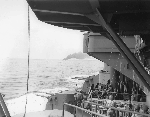
NS015736d |
285k |
USS Bunker Hill (CV-17) burning after
being attacked by Japanese kamikazes, as seen
from USS South
Dakota (BB-57), 11 May 1945.
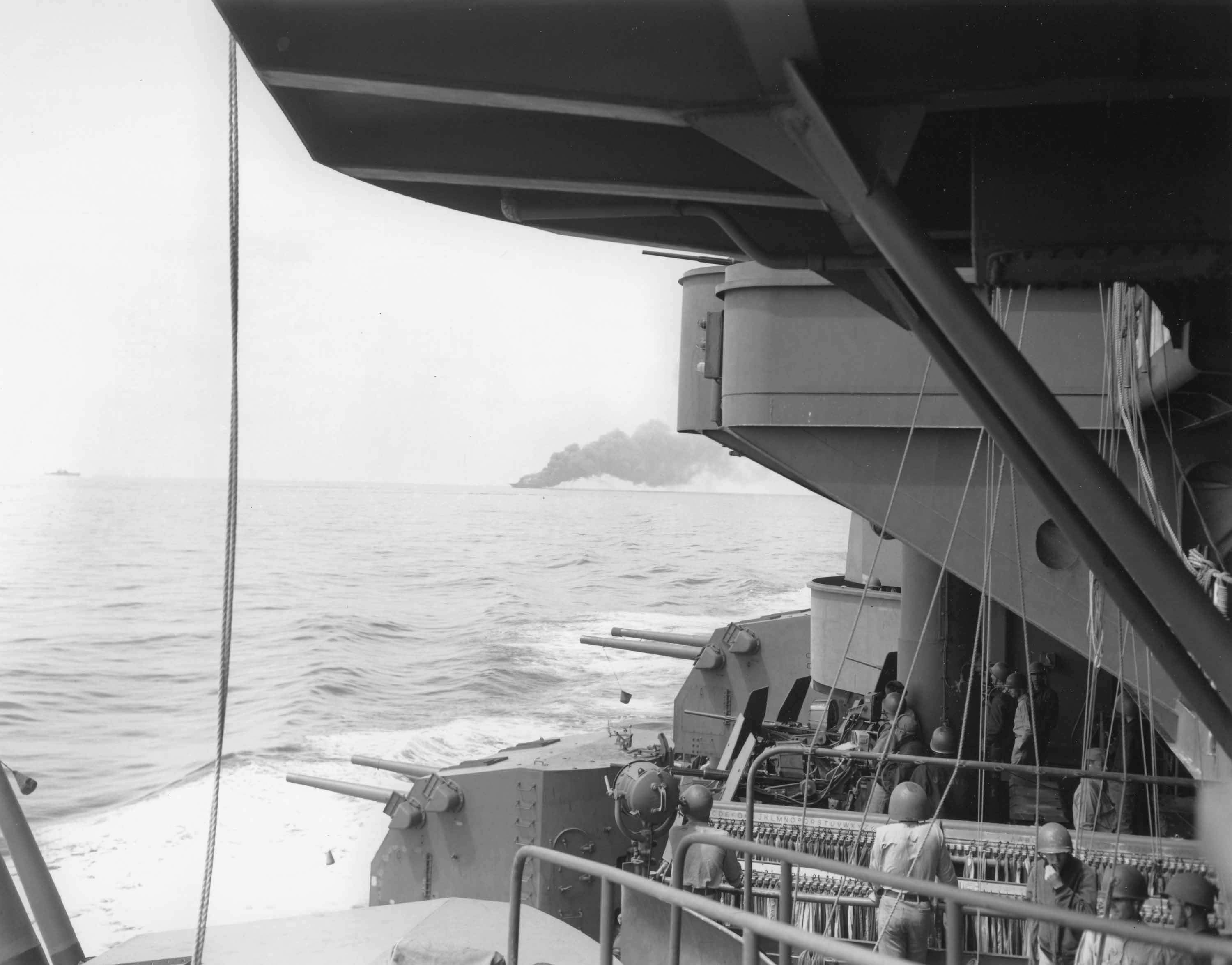
|
Pieter Bakels |

NS021702 |
87k |
Afire after being hit by two Kamikaze
suicide planes off Okinawa, 11 May 1945. Photographed
from USS Bataan
(CVL-29).
Official U.S. Navy Photograph, now in the
collections of the National Archives (photo #
80-G-274266).
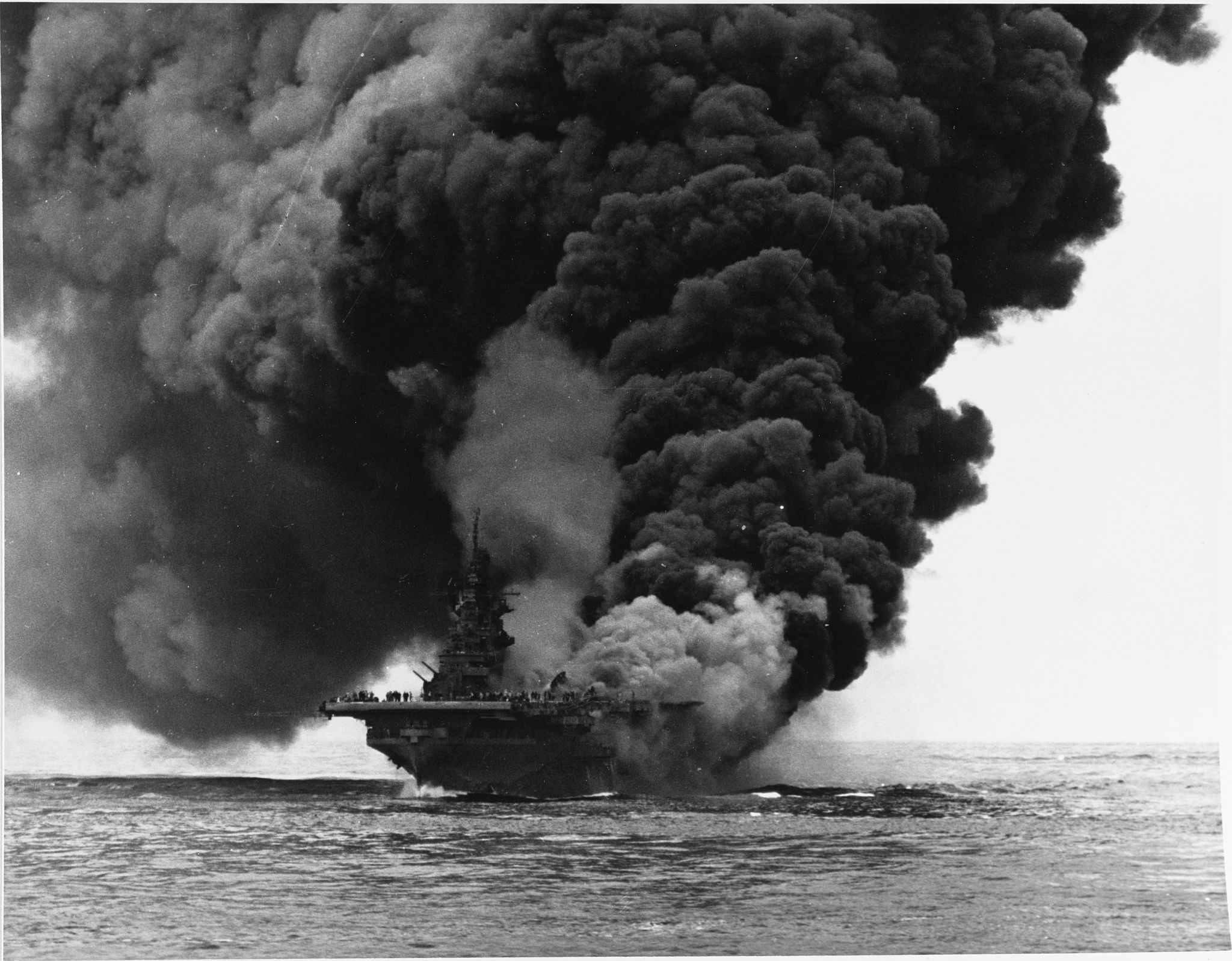
|
Scott Dyben |

NS021701 |
107k |
Scene on the carrier's flight deck, looking aft,
while her crew was fighting fires caused by Kamikaze
hits, off Okinawa on 11 May 1945.
Official U.S. Navy Photograph, now in the
collections of the National Archives (photo #
80-G-323712).
This widely known photograph was taken by Tony
Faccone with a Kodak K-4 camera resting directly on
the flight deck. The talker holding his huge helmet
down over his ears is Art Volkema, who had served most
of the war as a lookout in Air Aft, perched high up
just behind the stack on the back side of the island,
but had been transferred to the ship's bow the day
before—every man at his old position was killed in
the attack (Maxwell Taylor Kennedy, "Danger's
Hour,", Simon & Schuster, New York,
2008, pages 295, 360–361).
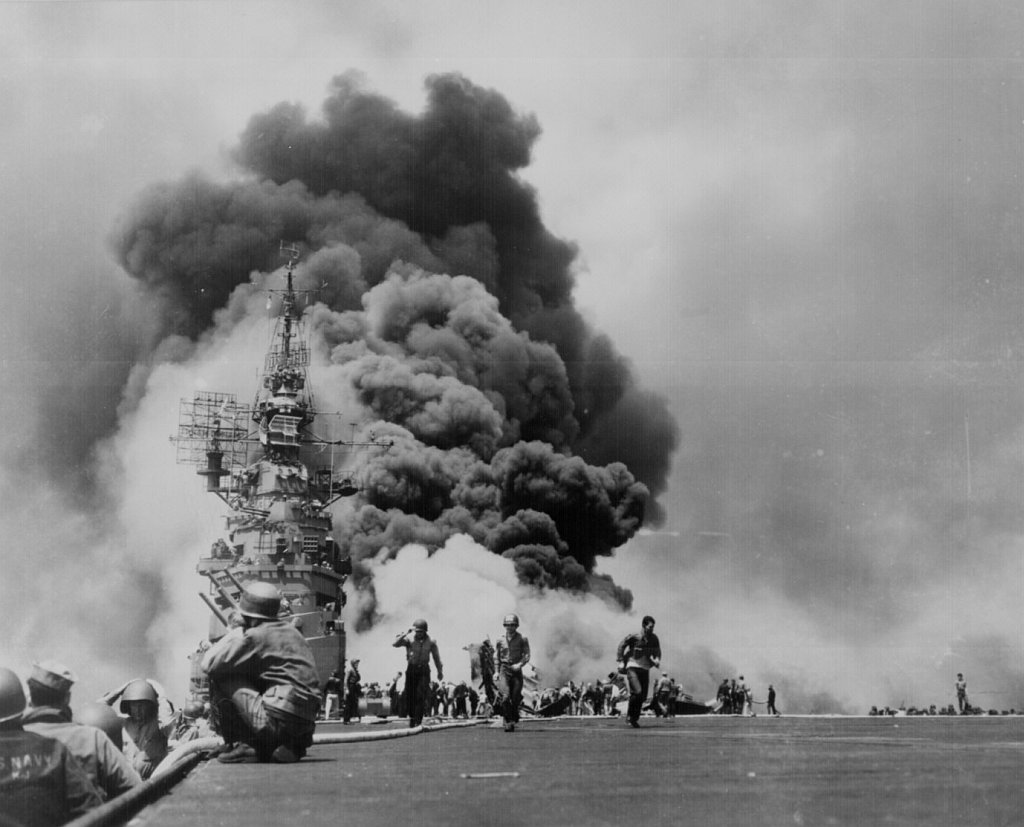
|
Initially submitted by Scott Dyben
Larger copy submitted by Pieter Bakels |

NS021701a |
114k |
Another view, similar to the one above,
but closer to the island.
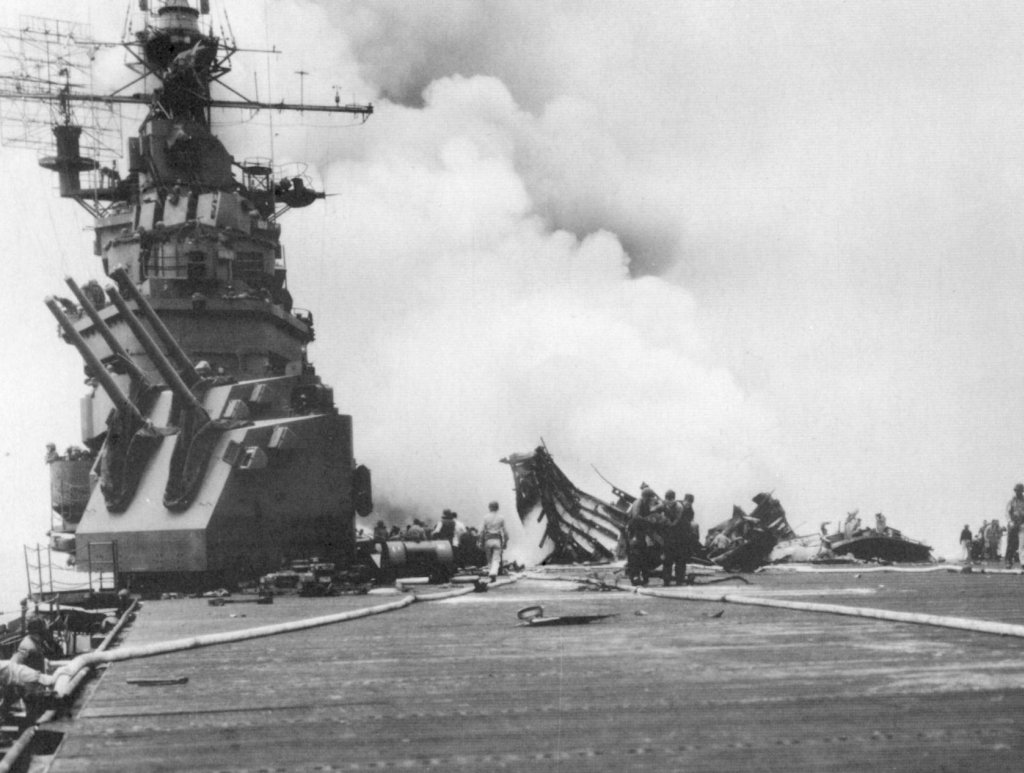
|
Courtesy of Scott Koen & ussnewyork.com |

NS021701b |
134k |
The hole in the flight deck and what was the
deck-edge elevator. A destroyer is alongside, possibly
USS English
(DD-696) or USS Charles
S. Sperry (DD-697).
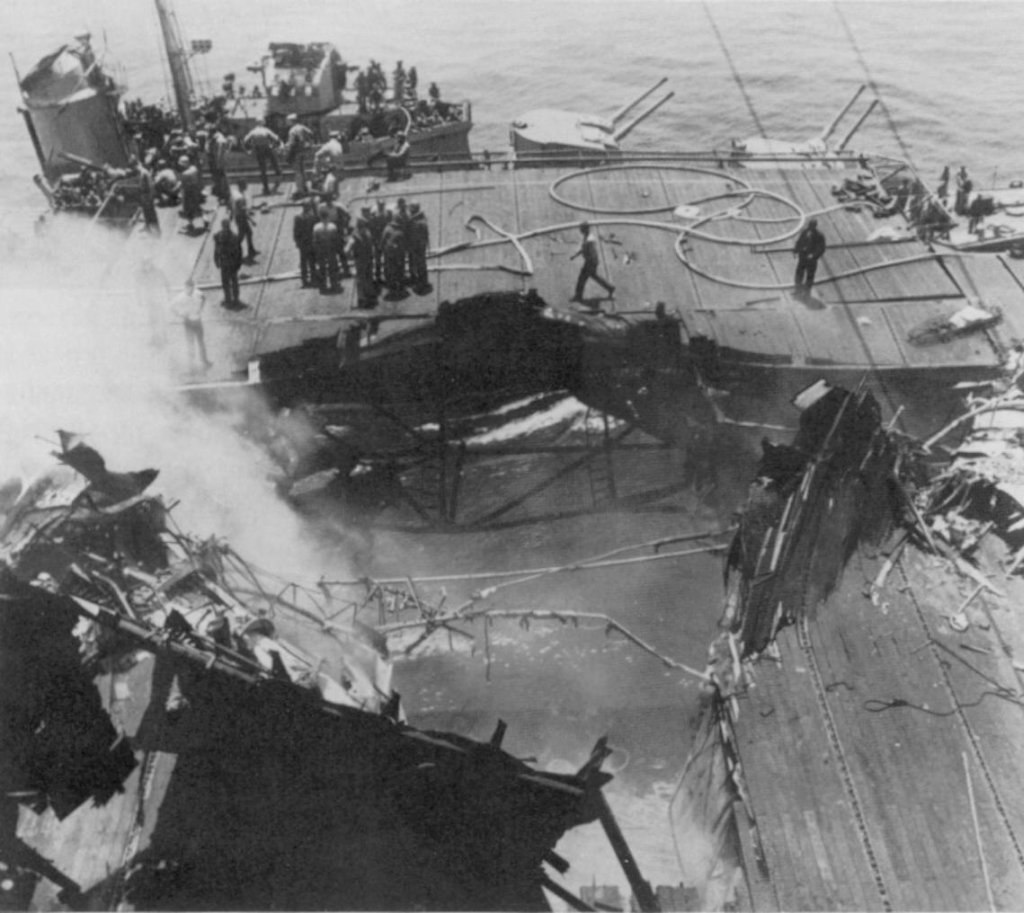
|
Courtesy of Scott Koen & ussnewyork.com |

NS021701c |
102k |
Fighting fires on the flight deck.
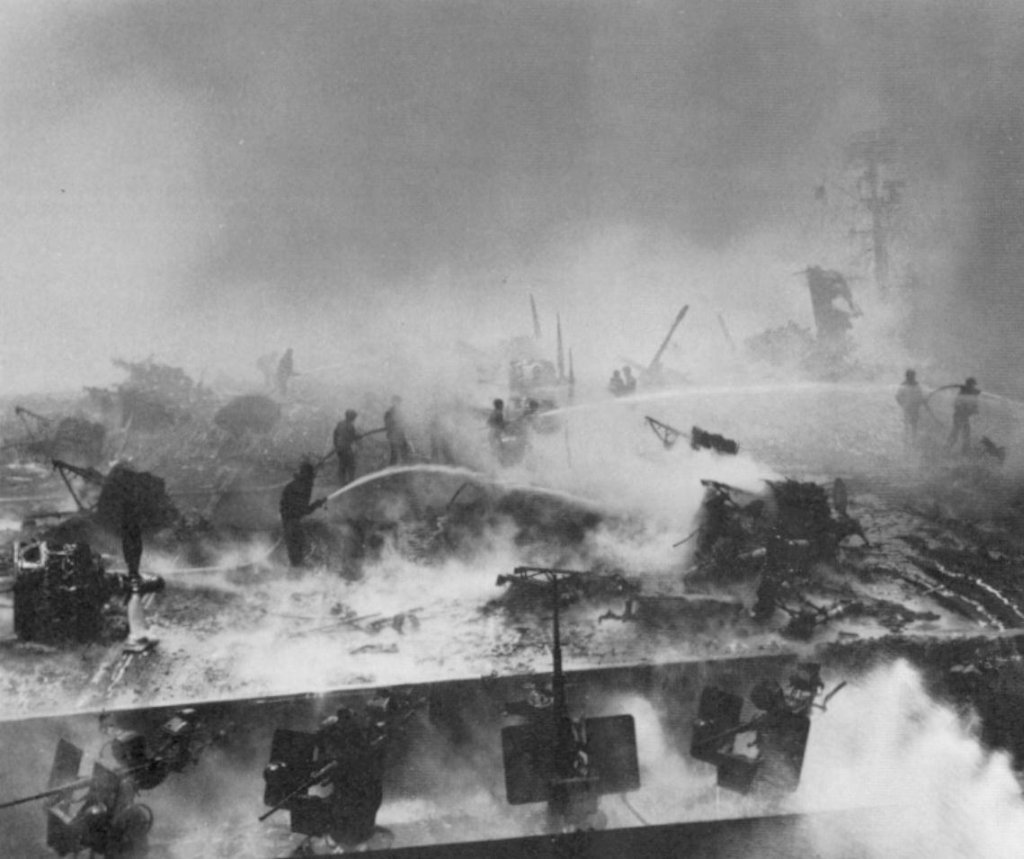
|
Courtesy of Scott Koen & ussnewyork.com |

NS021701d |
50k |
Burning fiercely.
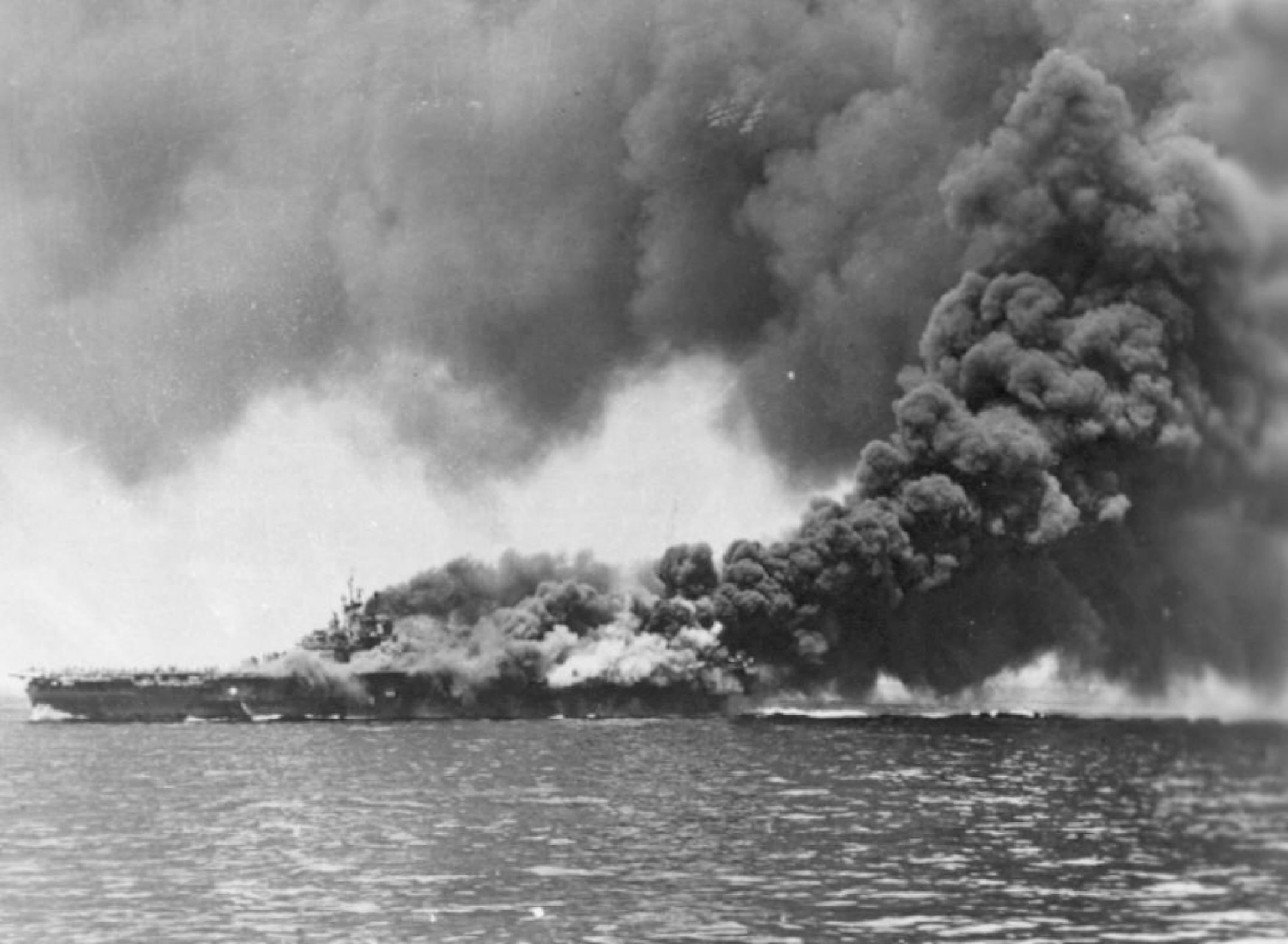
|
Courtesy of Scott Koen & ussnewyork.com |

NS021719 |
84k |
USS Bunker Hill (CV-17) burning after
being hit by "Kamikaze" suicide planes
during the Okinawa operation, 11 May 1945. A Cleveland
class light cruiser is steaming nearby, at left.
Official U.S. Navy Photograph, now in the
collections of the National Archives (photo #
80-G-K-5274).
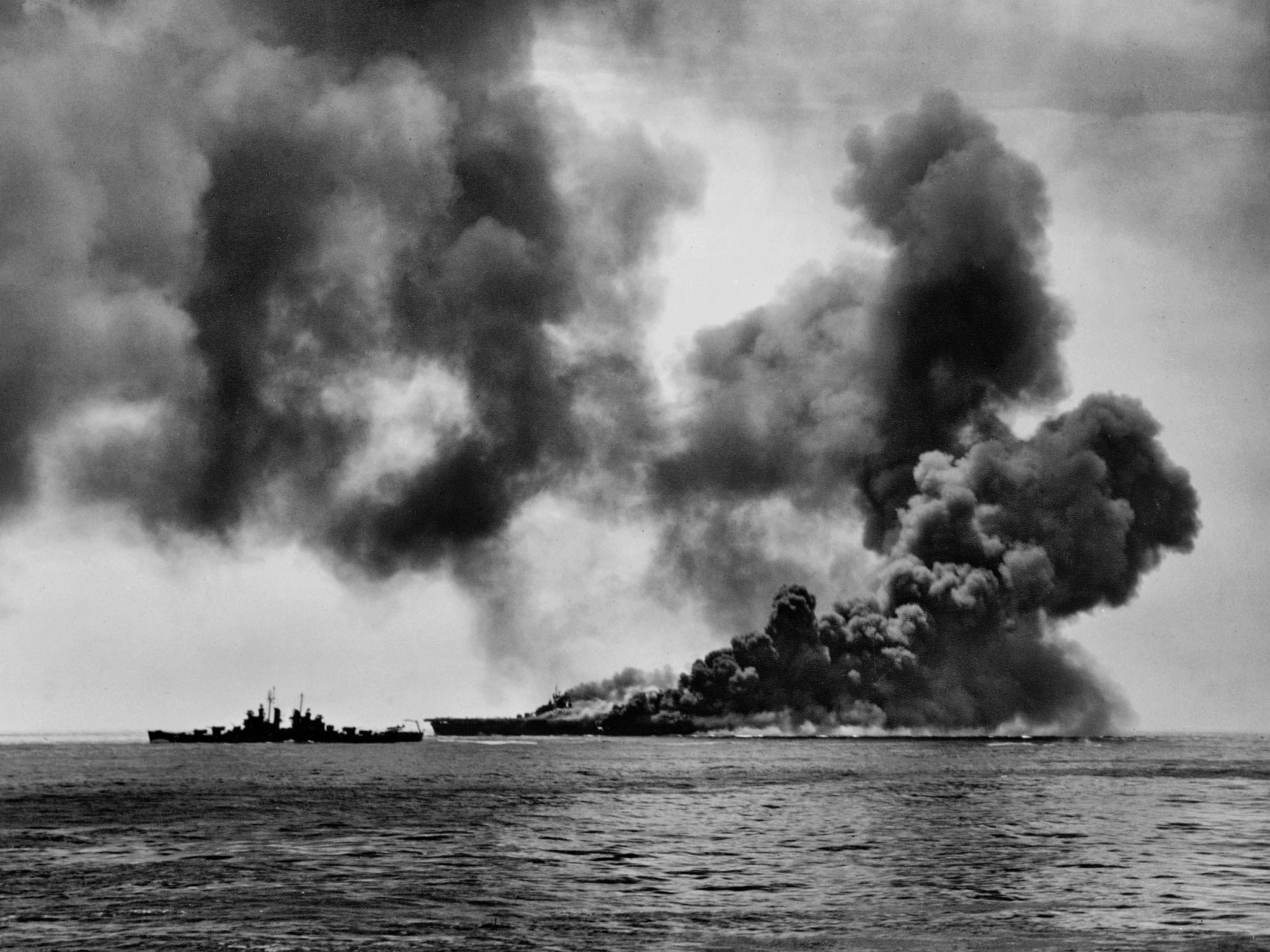
|
Scott Dyben |

NS021719a |
175k |
Port broadside view, 11 May 1945, of USS Bunker
Hill (CV-17) burning at the height of the
fires. USS Pasadena
(CL-65) is in the foreground.
US Navy and Marine Corps Museum/Naval Aviation
Museum, Photo No. 1983.046.010.043.
This image is part of an album of photographs
collected by Captain Carlos W. Wieber during his
command of the aircraft carrier Essex
(CV-9) during 1944–1945. Image mounted on a piece of
paper on which appears the original typewritten
caption.
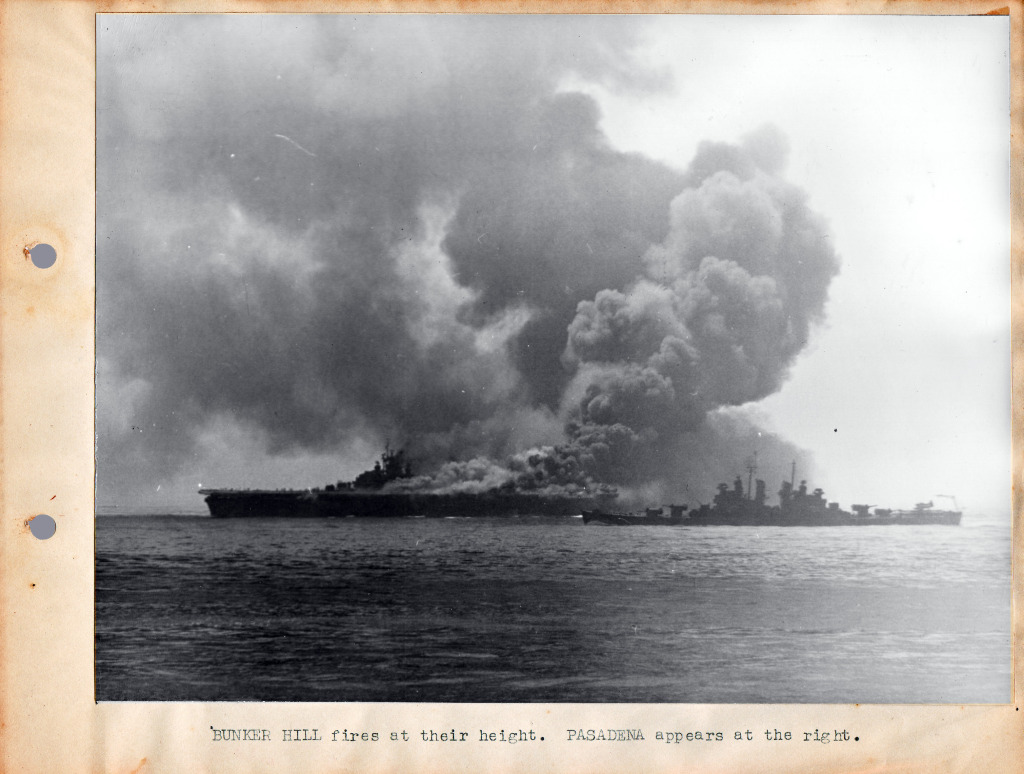
|
Mike Green |

NS021719b |
172k |
USS Bunker Hill (CV-17) being
assisted in fighting fires aboard by USS Charles
S. Sperry (DD-697) and USS Wilkes
Barre (CL-103), 11 May 1945.
US Navy and Marine Corps Museum/Naval Aviation
Museum, Photo No. 1983.046.010.144.
This image is part of an album of photographs
collected by Captain Carlos W. Wieber during his
command of the aircraft carrier Essex
(CV-9) during 1944–1945. Image mounted on a piece of
paper on which appears the original typewritten
caption.
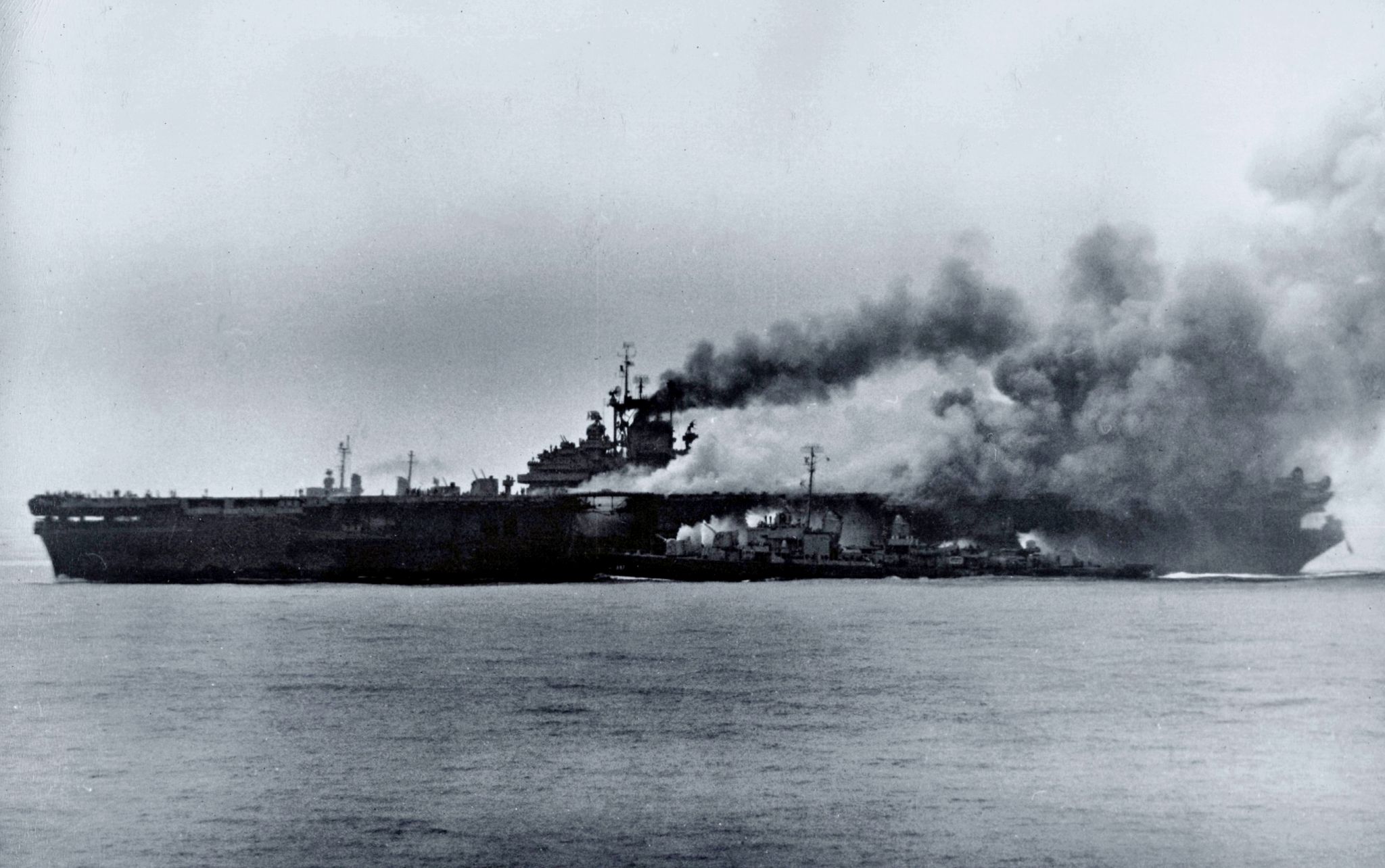
|
Mike Green |

NS021707 |
58k |
Burning fiercely after the hits,
the ship is turning into the wind to keep the flames
and smoke away from the bridge area.
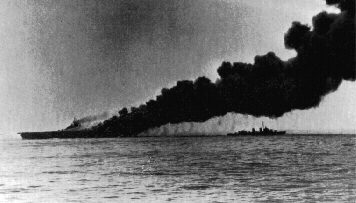
|
USN |

NS021708 |
57k |
The ship as seen from the carrier
USS Randolph
(CV-15). The cruiser USS Wilkes Barre (CL-103)
is in the background and is preparing to come
alongside to assist in fighting fires.
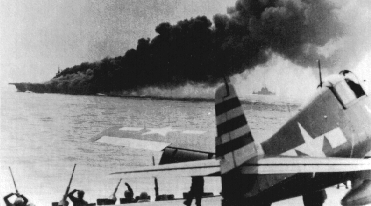
|
USN |

NS021715 |
81k |
Burning after being hit by a Kamikaze attack
while operating off Okinawa on 11 May 1945.
Photographed from USS Wilkes Barre (CL-103),
which appears to have received fire damage herself
helping to fight the blaze from alongside the carrier.
A destroyer is off Bunker Hill's port
side.
Official U.S. Navy Photograph, now in the
collections of the National Archives (photo #
80-G-328618).
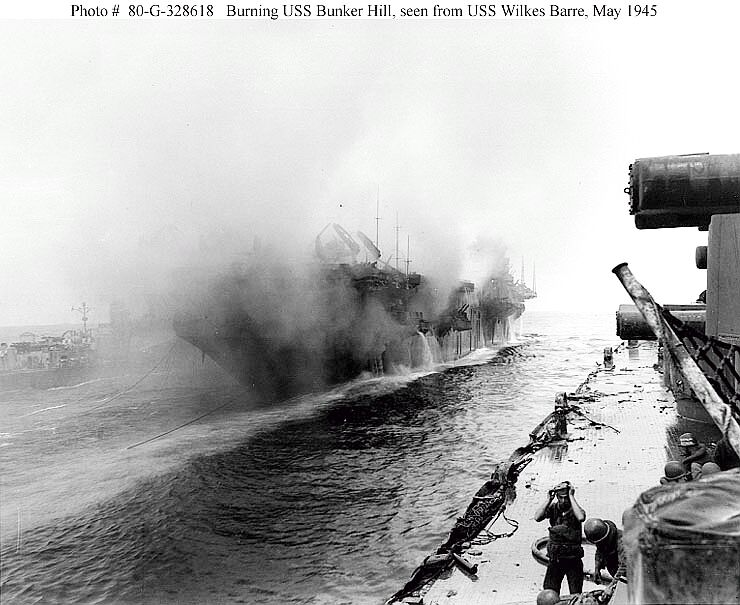
|
Scott Dyben |

NS021720 |
73k |
Casualties from Kamikaze hits are
transferred to USS Wilkes
Barre (CL-103) for medical care, off Okinawa
on 11 May 1945. Photographed from Wilkes Barre's
port side amidships, looking aft. Note SB2C aircraft
(one with a burned wing) parked aft on Bunker
Hill, smashed 40mm gun position on her
starboard side, smoke from still-burning fires, and
firefighting water streaming over her side. On Wilkes-Barre
note the 40mm quad gun mount in the foreground and the
electronic antenna above.
Official U.S. Navy Photograph, now in the
collections of the National Archives (photo #
80-G-328619).
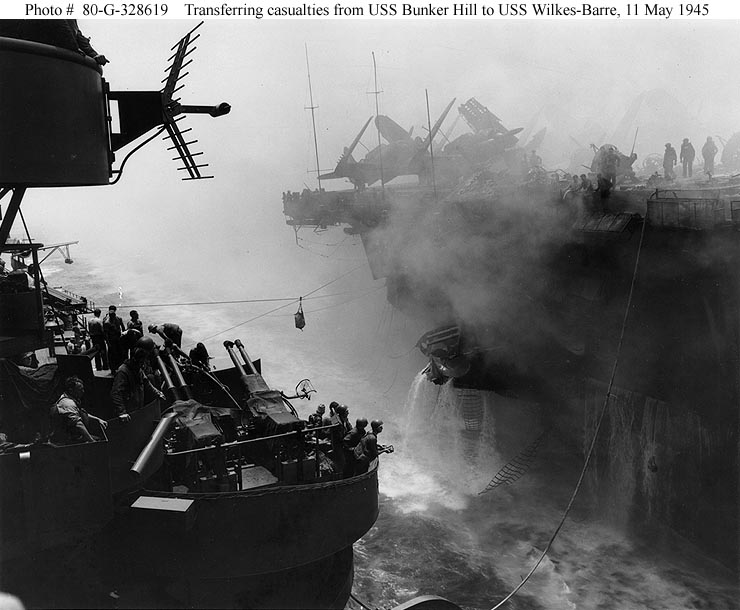
|
NHC |

NS021720a |
107k |
A casualty from the Kamikaze attack is
transferred to USS Wilkes
Barre (CL-103). (See above.)
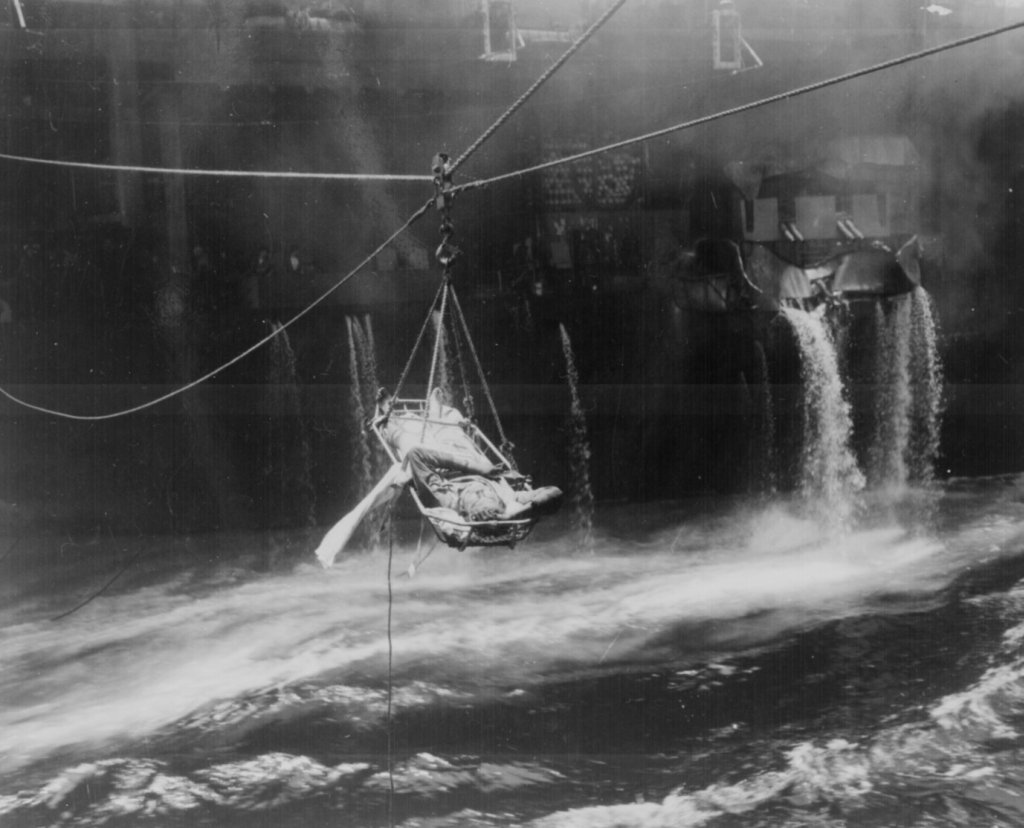
|
Pieter Bakels |

NS021709 |
126k |
The ship is seen listing to port
from all of the water poured on her fires and pouring
through her hull. A few undamaged Helldivers
can be seen on her stern.
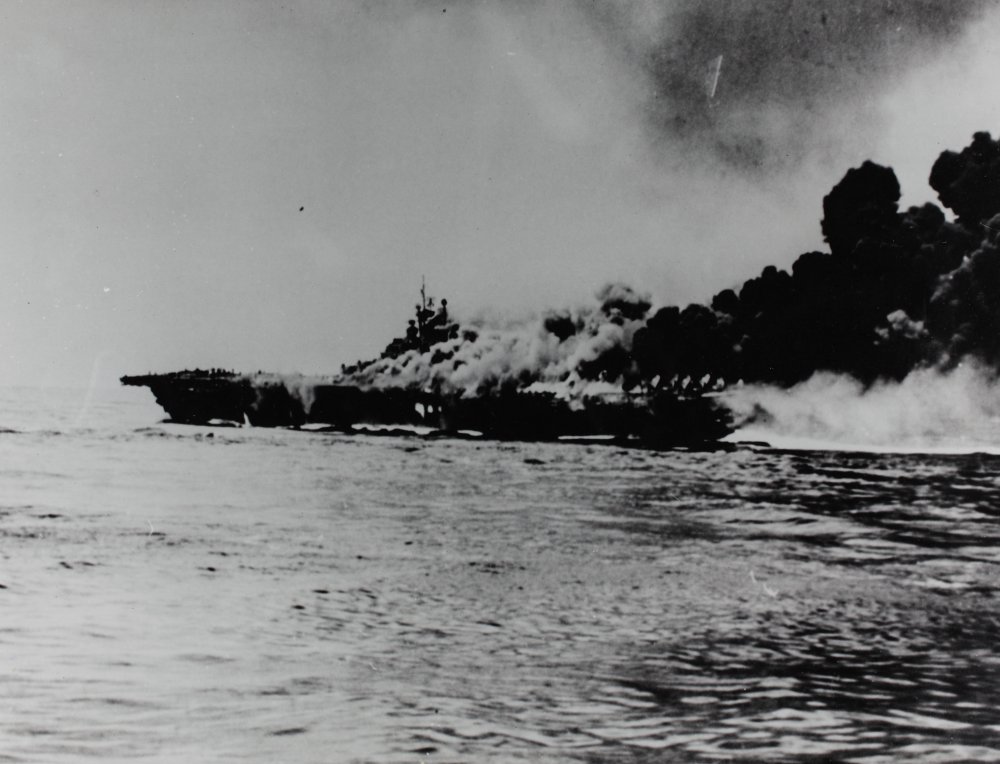
|
USN |

NS021709a |
59k |
USS Bunker Hill (CV-17) afire, as USS
The
Sullivans (DD-537) steams in the foreground. The
Sullivans promptly closed Bunker Hill
to render assistance and picked up 166 men forced over
the side by the fires that at one point ravaged the
carrier.
National Archives photo # 80-G-274264.
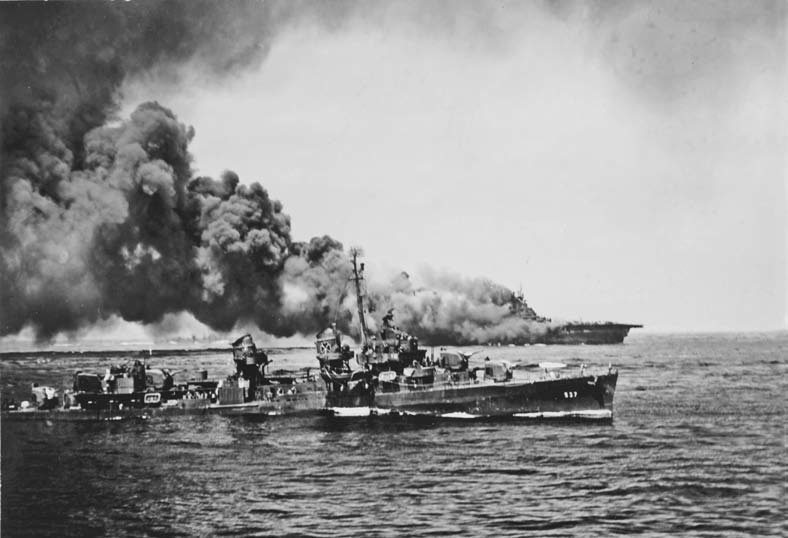
|
Gerd Matthes, Germany |

NS021710 |
182k |
With USS Wilkes
Barre (CL-103) alongside, the destruction of
the majority of her air group is shown aft of her
island.
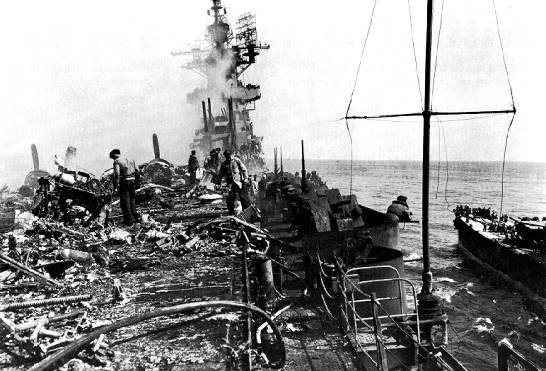
|
USN |

NS021710a |
103k |
USS Bunker Hill (CV-17) burned and
melted aircraft and damaged aft elevator are in
evidence after the Kamikaze attack of 11 May
1945.
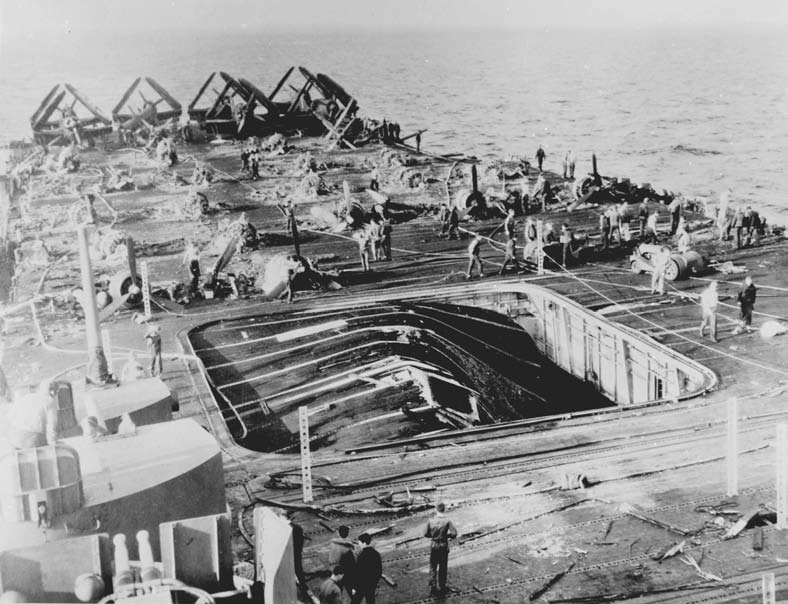
|
Gerd Matthes, Germany |

NS021734 |
118K |
Aircraft wreckage on the flight deck, after most
fires were out following hits by two Kamikazes
off Okinawa, 11 May 1945.
Official U.S. Navy Photograph, now in the
collections of the National Archives (# 80-G-259904).
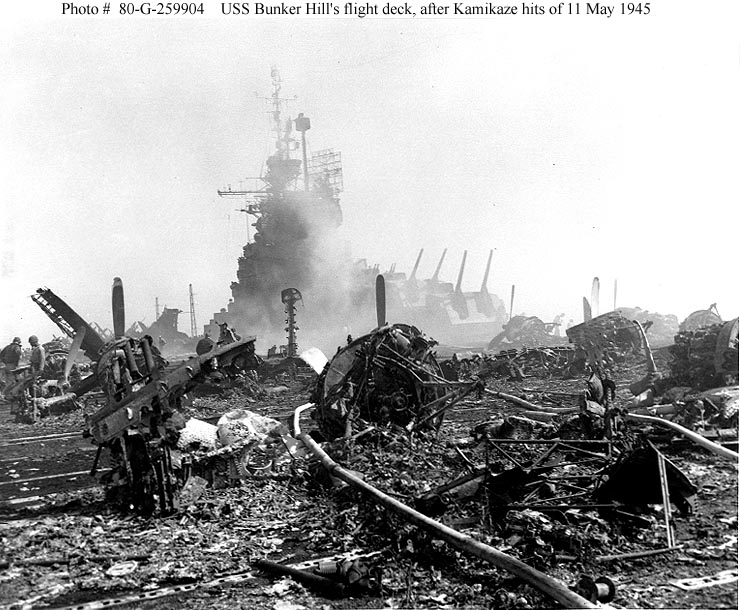
|
NHC |

NS021712 |
97K |
Alongside with the fires almost
out.
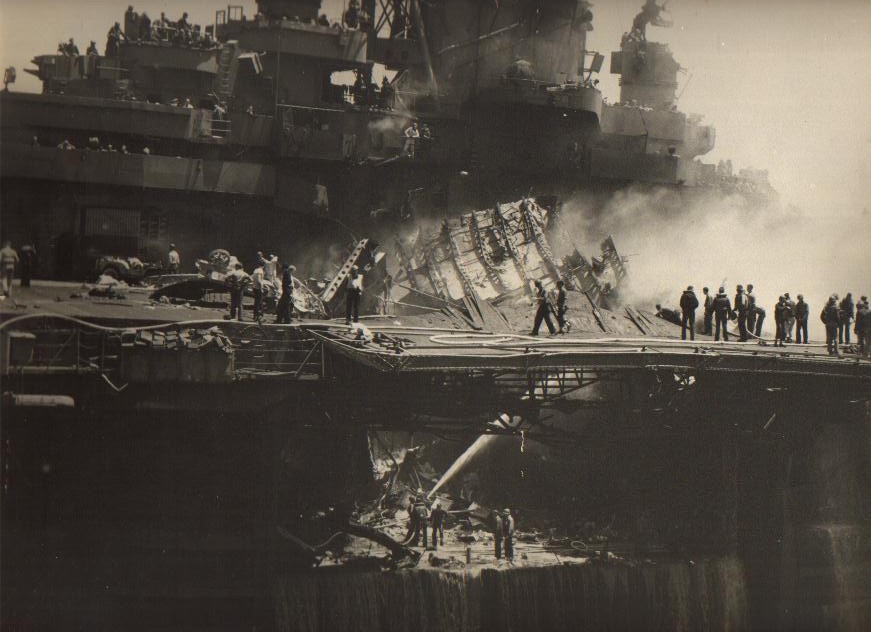
|
USN |

NS021711 |
126k |
The fires are out, but the damage
to her flight deck is shown in this photo. This is
where the forward most kamikaze struck the
ship.
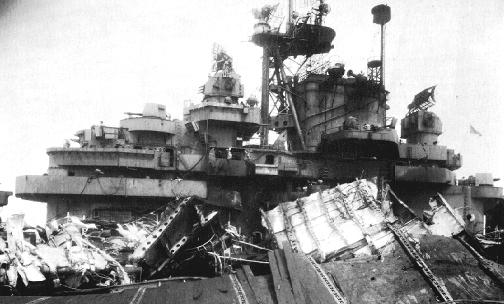
|
USN |

NS021731 |
81k |
Looking forward on the port side
of the island at frame 90 after kamikaze hit.
National Archives photo (# 80-G-323701).
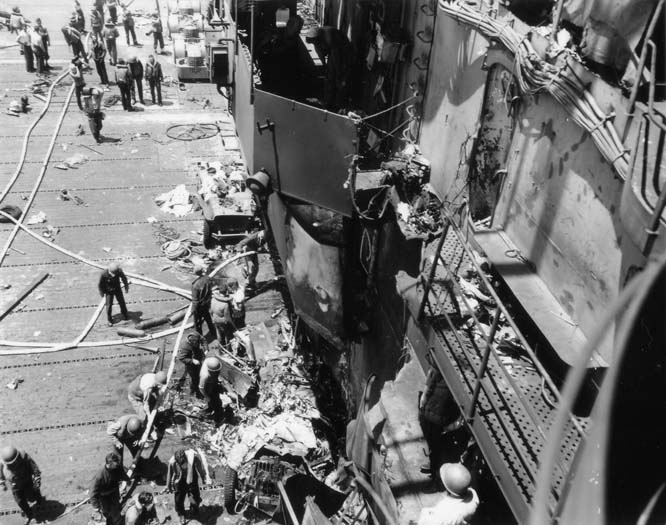
|
Tracy White, Researcher
@ Large |

NS021732 |
39k |
Another view of damage to the
flight deck. National Archives photo (# 80-G-323739).
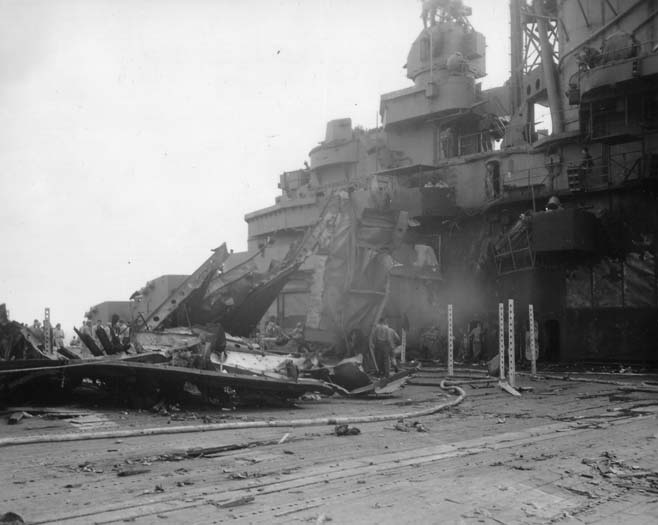
|
Tracy White, Researcher
@ Large |

NS021732a |
89k |
USS Bunker Hill (CV-17) crewmen look
over the bodies of their shipmates after the Kamikaze
attack of 11 May 1945.
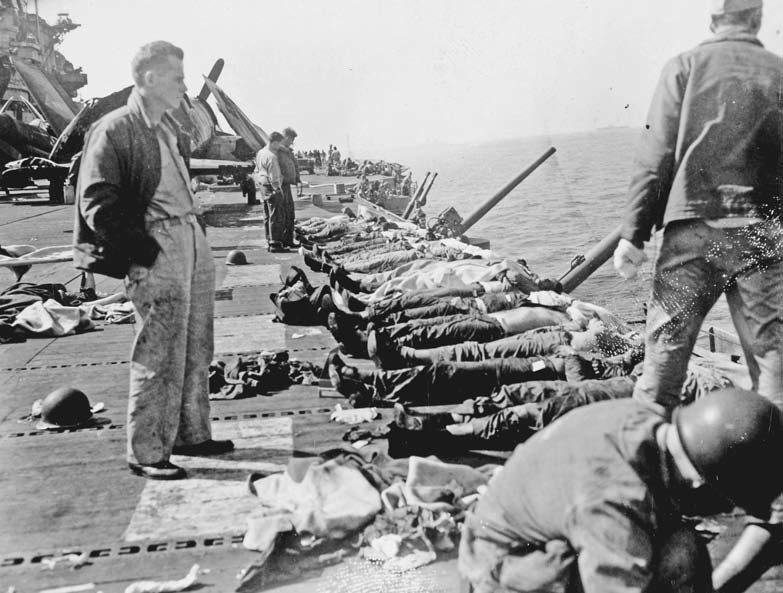
|
Gerd Matthes, Germany |

NS021732b |
268k |
In the name of the President of the United States,
the Commander, FIRST Carrier Task Force, Pacific,
presents the BRONZE STAR MEDAL to
COMMANDER CHARLES JOSEPH ODEND'HAL, JUNIOR
UNITED STATES NAVY
for service as set forth in the following
CITATION:
"For meritorious achievement in connection
with operations against the enemy while serving as
Navigator and Officer of the Deck; and later as
Executive Officer of a United States aircraft carrier
in the vicinity of Okinawa on 11 May 1945. After his
ship had been damaged by heavy enemy air attack, he
resolutely continued with his duties as Navigator and
Officer of the Deck, directing bridge activities and
restoring communications. When the Executive Officer
collapsed from wounds, he took over the duties of
Executive Officer, capably and courageously
supervising the activities of damage control, ship
control, medical aid and ship's defense. His efforts
contributed materially to the saving of his ship and
his leadership was at all times in keeping with the
highest traditions of the United Service."
FREDERICK C. SHERMAN
Vide Admiral, U. S. Navy.
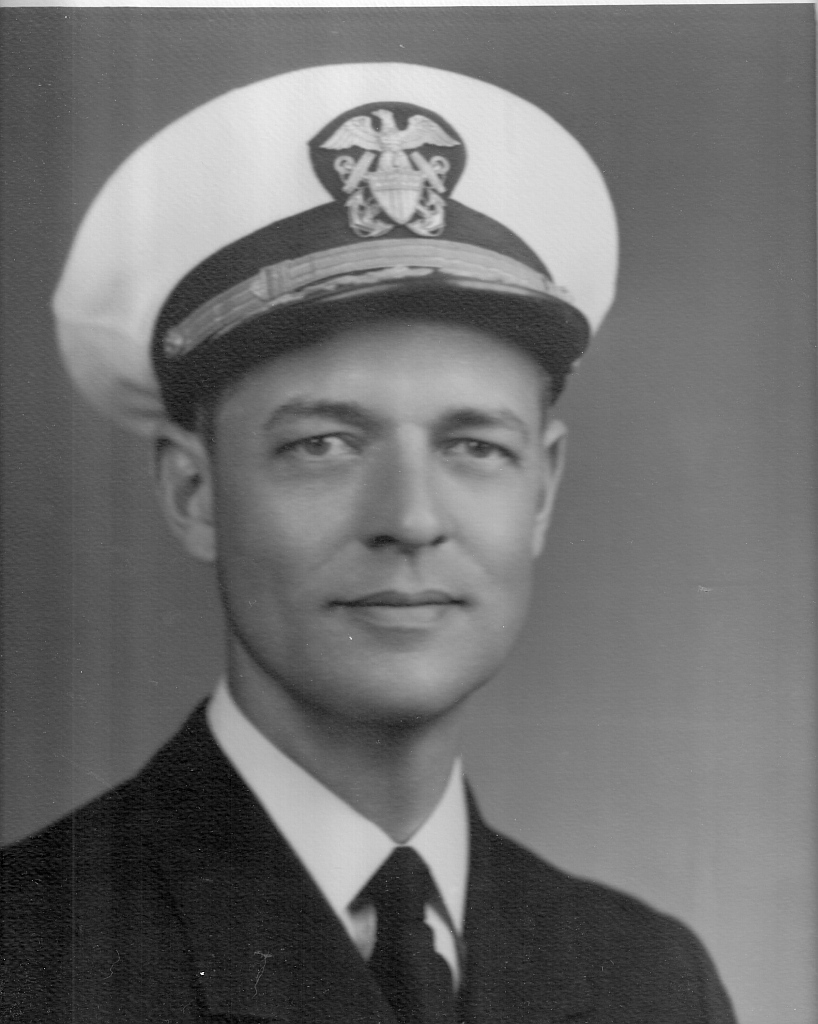 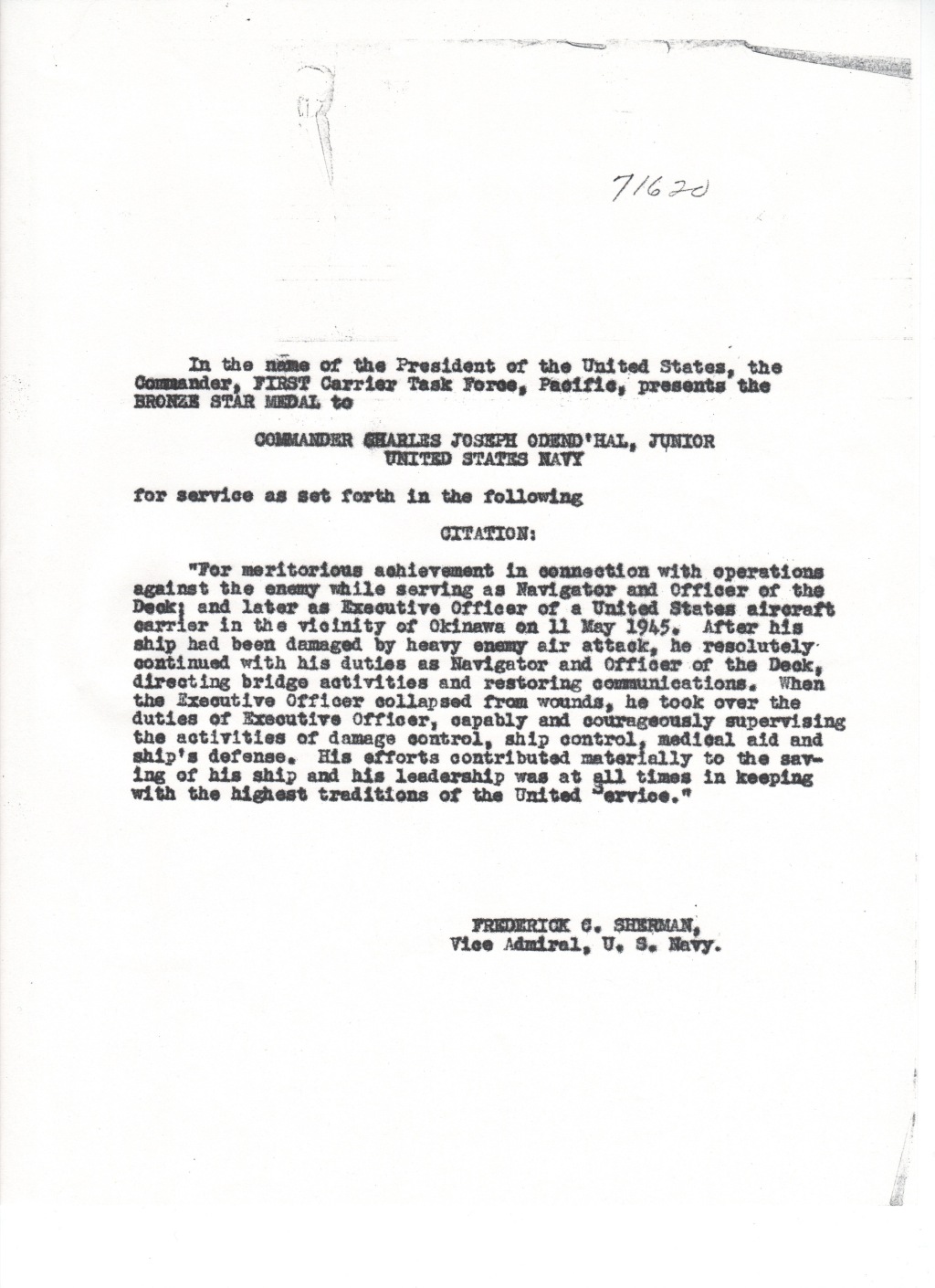
|
The Odend'hal Family |

NS021732c |
251k |

NS021724 |
76k |
USS Bountiful (AH-9) taking casualties on
board from USS Bunker Hill (CV-17) on 12
May 1945, one day after the carrier was devastated by
a kamikaze attack. USS The Sullivans
(DD-537) is in the foreground. Photographed by PhoM2/c
F. W. Pataye, USN of Commander Service Squadron 6.
Official U.S. Navy Photograph, now in the
collections of the National Archives (# 80-G-350765).
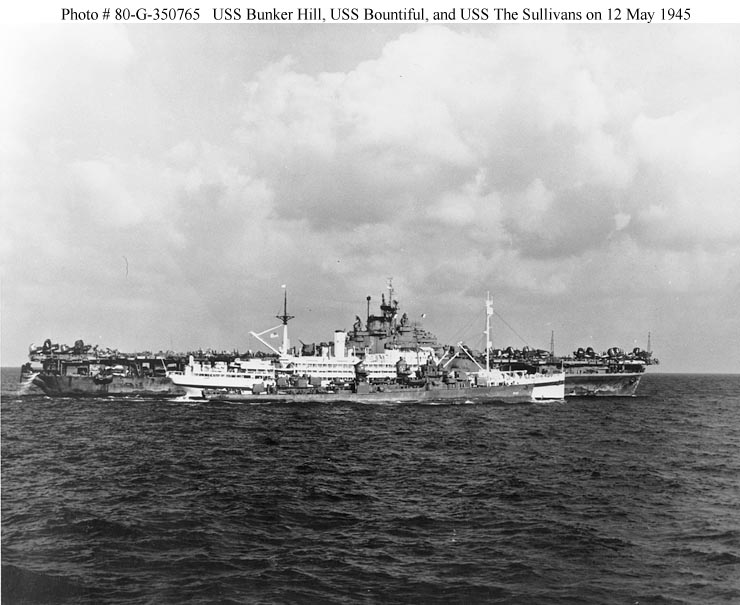
|
NHC |

NS021728 |
78k |
Puget Sound Navy Yard. Damage in action of 11 May
1945. Hit No. 2, looking fwd. from aft side of No. 2
elevator.
Seattle Branch of the National Archives photo.
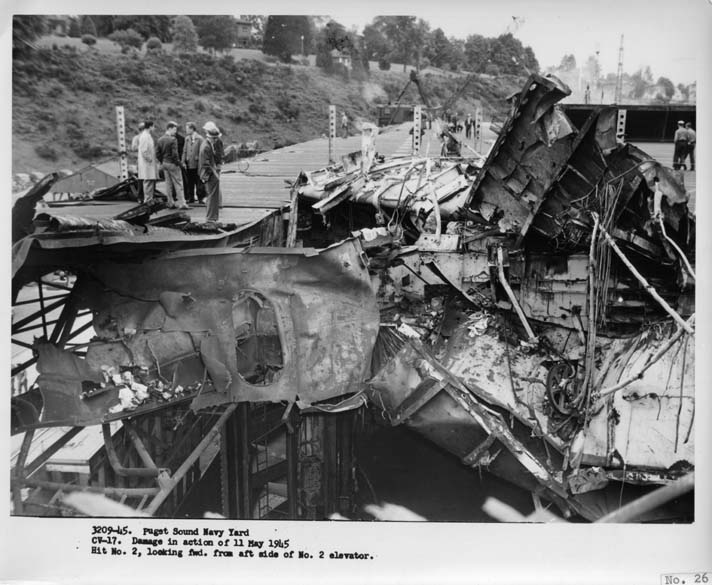
|
Tracy White, Researcher
@ Large |

NS021729 |
74k |
Puget Sound Navy Yard, 12 June 1945. Aftermost
damaged section at Fr. 180 looking aft.
Seattle Branch of the National Archives photo.
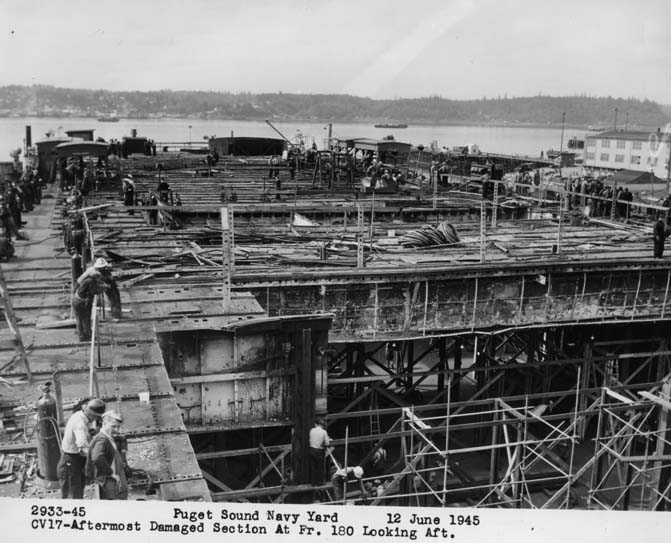
|
Tracy White, Researcher
@ Large |

NS021730 |
106k |
Puget Sound Navy Yard, 17 June 1945. Looking Forw'd
and to port from fr.164 flight deck.
Seattle Branch of the National Archives photo (RG
181).
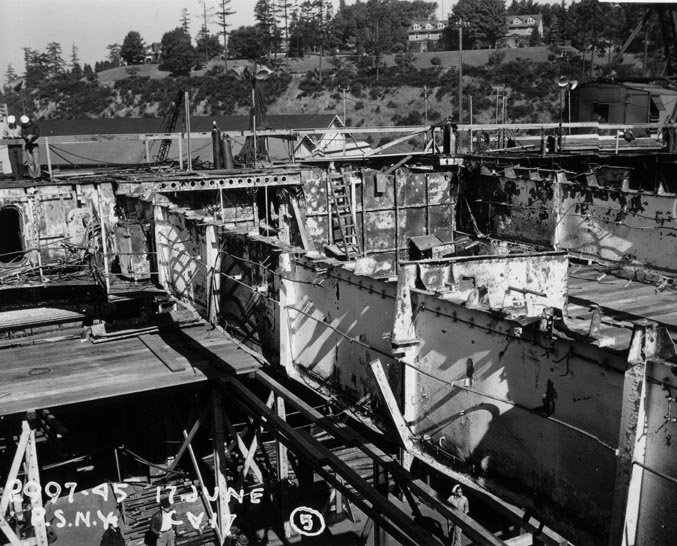
|
Tracy White, Researcher
@ Large |

NS1425027301 |
36k |
The covered lighter YF-273 alongside the
aircraft carrier USS Bunker Hill (CV-17)
at Puget Sound Navy Yard, 19 July 1945. After these
repairs, Bunker Hill took part in Magic
Carpet transport operations bringing home US
military personnel from the Pacific area up until the
end of her service life. US Navy photo.

|
Robert Hurst |

NS021740 |
169K |
USS Bunker Hill (CV-17) in a photo
most likely taken in or after October 1945.
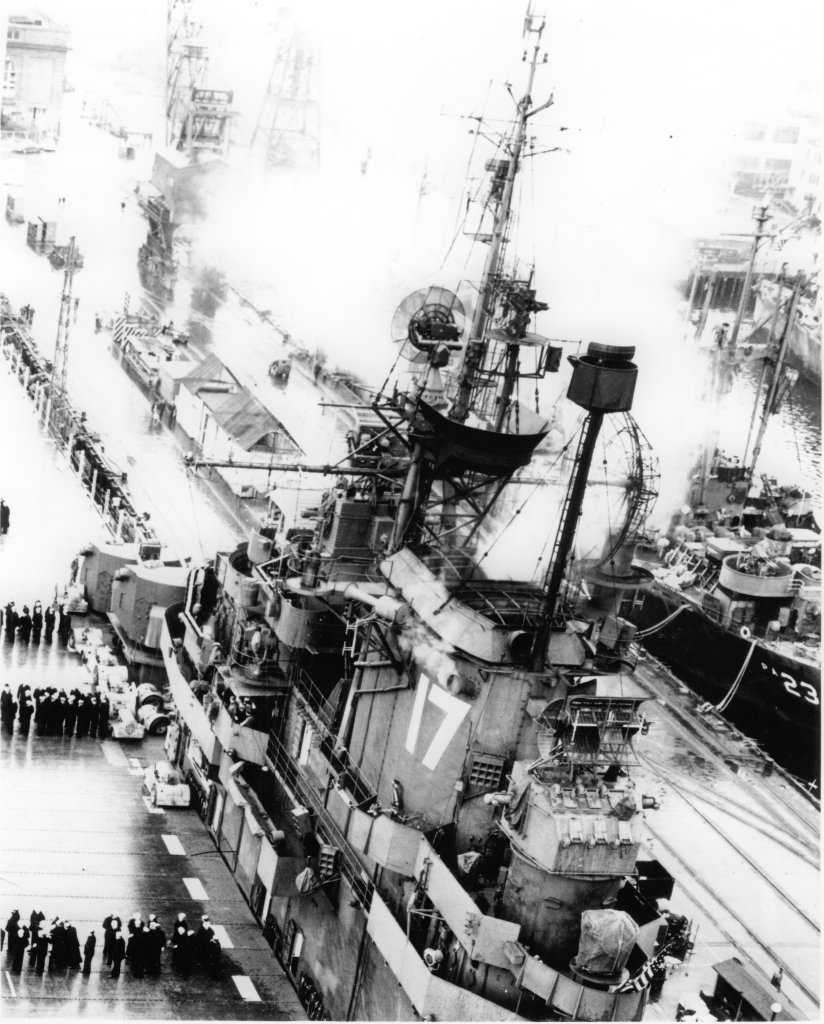
|
Pieter Bakels |
Memorabilia
|

NS021738 |
110k |
Ship's Bell, Evergreen
Aviation & Space Museum ("Home of the
Spruce Goose"), McMinnville, Oregon. (Note TBM-3E
Avenger just behind the bell.)
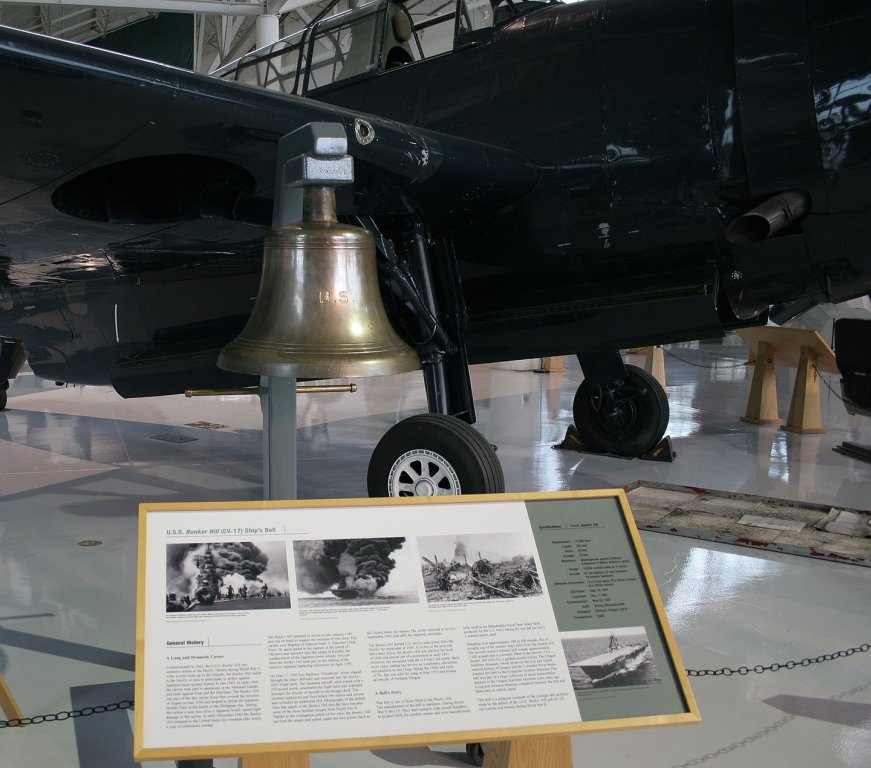
|
Larry Lee |
"Welcome
Aboard"
|

NS021736 |
221k |
"Welcome Aboard" pamphlet for USS Bunker
Hill (CV-17), dated 1945.
|
Robert M. Cieri |

NS021736a |
226k |

NS021736b |
186k |
In
Reserve
|

NS021751 |
59k |
Bunker Hill (CV-17) at North Island,
California, circa 1947, after being mothballed. Photo
Robert L. Lawson, from Carrier
Air War in Original Color, by Robert Lawson
and Barrett Tillman.
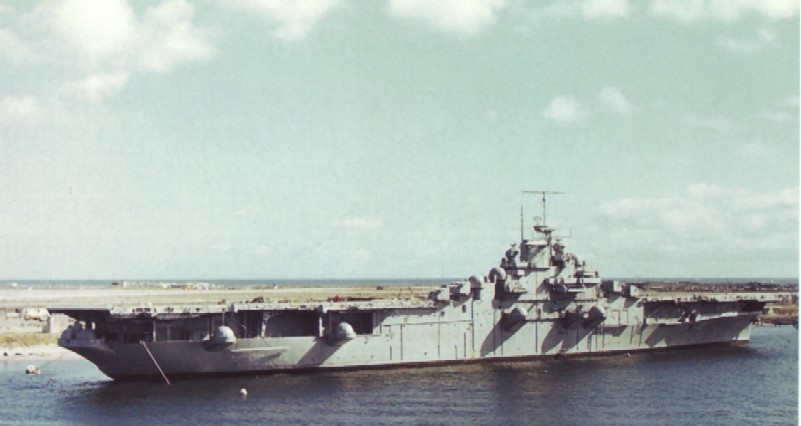
|
Robert Hurst |

NS021704 |
46k |
San Diego, February 5, 1966. |
©Richard Leonhardt |

NS021705 |
85k |
San Diego, February 5, 1966. |
©Richard Leonhardt |
As
an Electronics Test Platform
|

NS021735 |
79K |
Ex-Bunker Hill moored off Point Loma,
San Diego, after conversion to an electronics test
hulk, date unknown.
|
Robert Hurst |

NS021750 |
192k |
Ex-USS Bunker Hill (ex-AVT 9)
moored at North Island, San Diego, around 1968.
|
Photo by Ed Pietzuch |

NS021746 |
46k |
Ex-USS Bunker Hill (ex-AVT 9)
tied up at Naval Air Station, North Island, San Diego,
California, in October 1968.
|
Richard Leonhardt |

NS021752 |
55k |
The electronics test platform ex-USS Bunker
Hill tied up [at] San Diego, California, on 25
June 1970. This photograph shows several special
antennas on the island. One of the three quad mounts
on the starboard side below the island has been
removed, and the other "mothballed." Photo
courtesy L. R. Cote.
Photo and text from Aircraft
Carriers of the U.S. Navy, by Stefan
Terzibaschitsch.
|
Robert Hurst |

NS021721 |
133k |
Ex-USS Bunker Hill (ex-AVT-9) tied up
at Naval Air Station, North Island, San Diego,
California, in October 1971. Though stricken from the
Naval Vessel Register, she was still employed as a
test platform for the Naval Electronics Laboratory
Center.
Official U.S. Navy Photograph (USN 1150533).
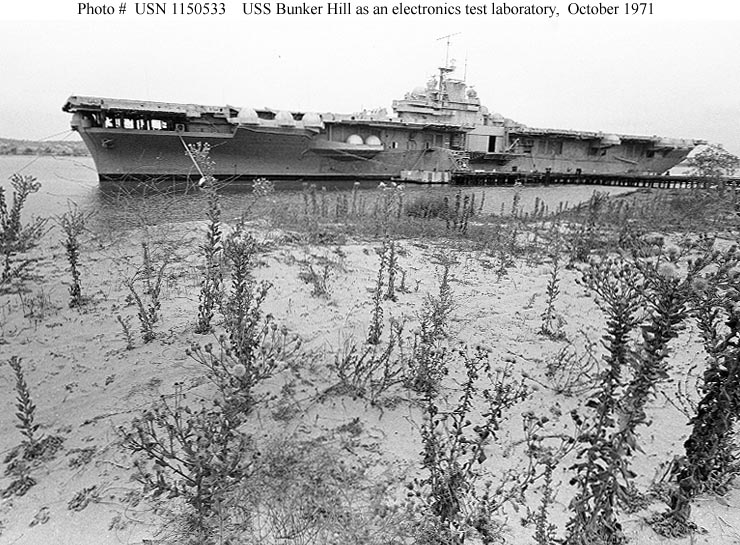
|
NHC |

NS021725 |
44k |
This is a scan of a Polaroid of the ex-USS Bunker
Hill taken in 1972 when she was at NAS North
Island in San Diego.
|
M. J. "Doc" Sanchez HM2 (FMF) USN
Ret. |
View the USS Bunker Hill (CV-17 / CVA-17 / CVS-17 /
AVT-9)
DANFS
History entry located on the Naval
Historical Center Web Site.
| Crew
Contact and Reunion Information |
|
|
Comments, Suggestions or Image submissions, E-mail Carrier
Information
Problems and site related matters, E-mail Webmaster
This page was created by Paul Yarnall
and is maintained by Fabio Peña

|

DEPARTMENT OF THE NAVY -- NAVAL HISTORY AND
HERITAGE COMMAND
805 KIDDER BREESE SE -- WASHINGTON NAVY YARD
WASHINGTON DC 20374-5060
http://www.history.navy.mil/danfs/b10/bunker%20hill-i.htm |
Bunker Hill
Bunker Hill is a height in Charlestown,
Mass. The battle, which bears this name, was fought 17
June 1775 on adjacent Breed's Hill.
-----
After she was acquired by the Navy on 12
November 1917 for service in World War I, the coastal steamer
Bunker Hill (Id. No. 1256) was converted to a minelayer and
renamed Aroostook (q.v.).
(CV-17; dp. 27,100; 1. 872'; b. 93'; dr. 28'7"; s. 32.7
k.; cpl. 3448; a. 12 5"; cl. Essex)
Bunker Hill (CV-17) was launched 7
December 1942 by Bethlehem Steel Co., Quincy, Mass.; sponsored
by Mrs. Donald Boynton; and commissioned 24 May 1943, Captain
J. J. Ballentine in command.
Reporting to the Pacific in the fall of 1943 Bunker Hill
participated in carrier operations during the Rabaul strike
(11 November 1943); Gilbert Islands operation, including
support of the landings on Tarawa (13 November-8 December);
the Kavieng strikes in support of the Bismarck Archipelago
operation (25 December 1943, 1 and 4 January 1944); Marshall
Islands operation (29 January-8 February); strikes against
Truk (17-18 February), during which eight Japanese combatant
vessels were sunk; Marianas raid (23 February); Palau-Yap-Ulithi-Woleai
raids (30 March-1 April); Truk-Satawan-Ponape raids (29
April-1 May); Hollandia operation (21-28 April); and Marianas
operation (12 June-10 August), including the Battle of the
Philippine Sea. On 19 June 1944, during the opening phases of
the battle, Bunker Hill was damaged when an enemy near
miss scattered shrapnel fragments across the ship. Two men
were killed and over 80 were wounded. Bunker Hill
continued to do battle and her planes aided in sinking one
Japanese carrier and destroying a part of the 476 Japanese
aircraft that were downed. During September she participated
in the Western Caroline Islands operation and then launched
strikes at Okinawa, Luzon, and Formosa until November.
On 6 November Bunker Hill retired from the forward area
and steamed to Bremerton, Wash., for a period of yard
availability. Repairs completed, she departed the west coast
24 January 1945 and returned to the war front. During the
remaining months of World War II Bunker Hill
participated in the Iwo Jima operation and the 5th Fleet raids
against Honshu and the Nasei Shoto (15 February-4 March); and
the 5th and 3d Fleet raids in support of the Okinawa
operation. On 7 April 1945 Bunker Hill's planes took
part in a fast carrier task force attack on a Japanese naval
force in the East China Sea. The enemy battleship Yamato,
one cruiser, and four destroyers were sunk.
On the morning of 11 May 1945, while supporting the Okinawa
invasion, Bunker Hill was hit and severely damaged by
two suicide planes. Gasoline fires flamed up and several explosions
took place. The ship suffered the loss of 346 men killed, 43
missing, and 264 wounded. Although badly crippled she managed
to return to Bremerton via Pearl Harbor.
In September Bunker Hill reported for duty with the
"Magic Carpet" fleet. She remained on this duty as a
unit of TG 16.12 returning veterans from the Pacific until
January 1946 when she was ordered to Bremerton for
inactivation. She was placed out of commission in reserve
there 9 January 1947.
Bunker Hill received the
Presidential Unit Citation for the period 11 November 1943 to
11 May 1945. In addition, she received 11 battle stars for her
World War II service.
Bunker Hill's designation was changed from CV-17 to
CVA-17 on 1 October 1952 and from CVA-17 to CVS-17 on 8 August
1953. She was struck from the Navy listing on 1 November 1966
and retained as a moored electronic test ship at San Diego,
Calif., until November 1972 and then scrapped in 1973.
|
| |
|
|